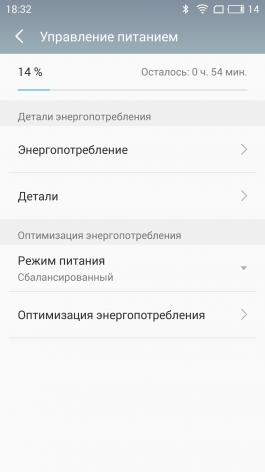Review of the Meizu M3 Note smartphone: a polished phablet. A balanced mid-level model with a Full HD screen and a fingerprint sensor.
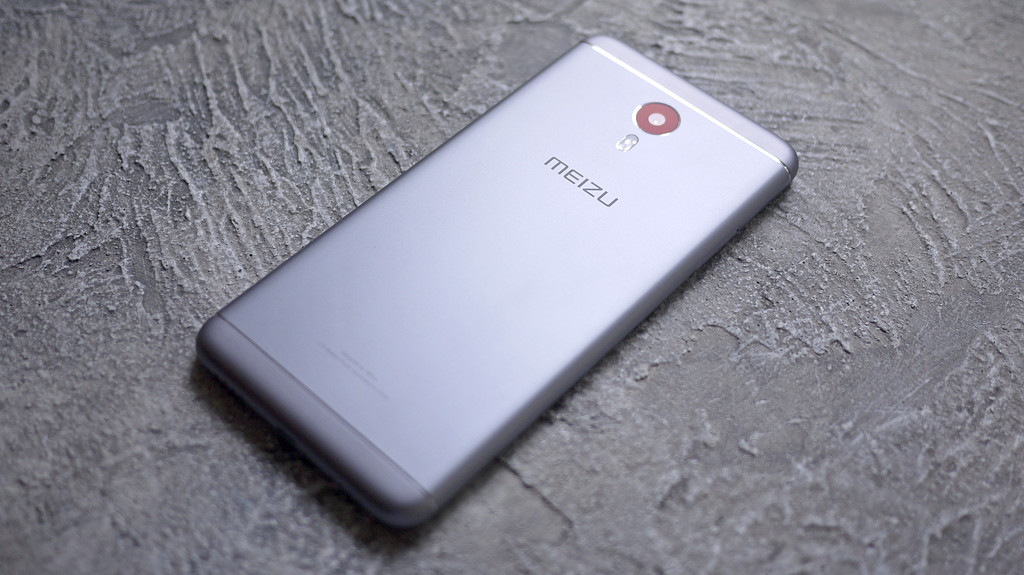
Thus, for the manufacture of the all-metal body of the new product, also known as unibody, we chose an aviation aluminum-magnesium alloy of the 6000 series.
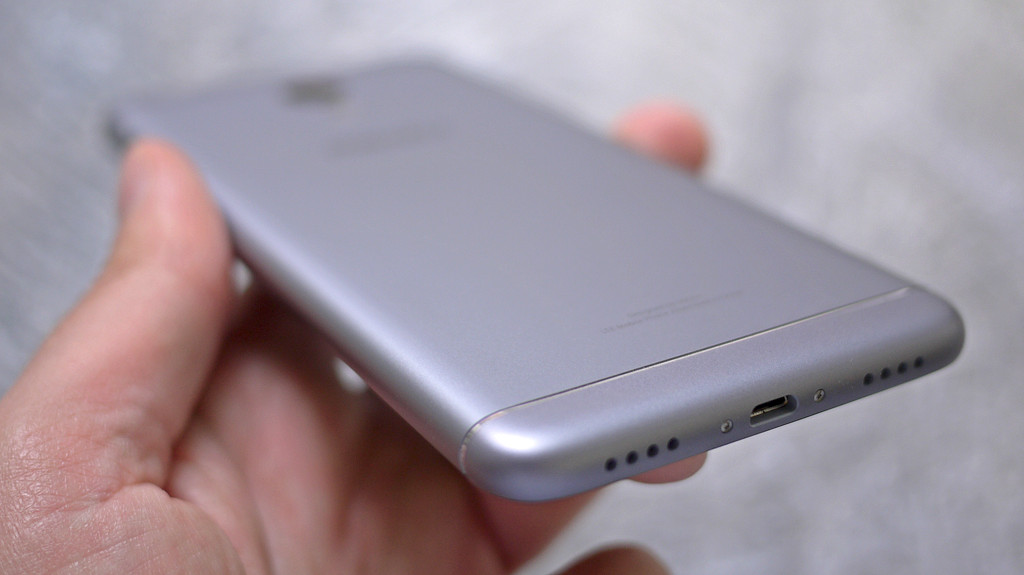
To prevent the smartphone antennas from being shielded by metal, two inserts made of radio-transparent material were provided, separating them from the aluminum alloy with raised strips. The dimensions of the new product have not changed very significantly compared to the previous version - 153.6x75.5x8.2 mm versus 150.7x75.2x8.7 mm. Well, the weight has predictably increased due to the more capacious battery - 163 g versus 149 g.
Let us remember that in its predecessor they were content with glossy colored plastic for the body and only for gray Matte polycarbonate was used.
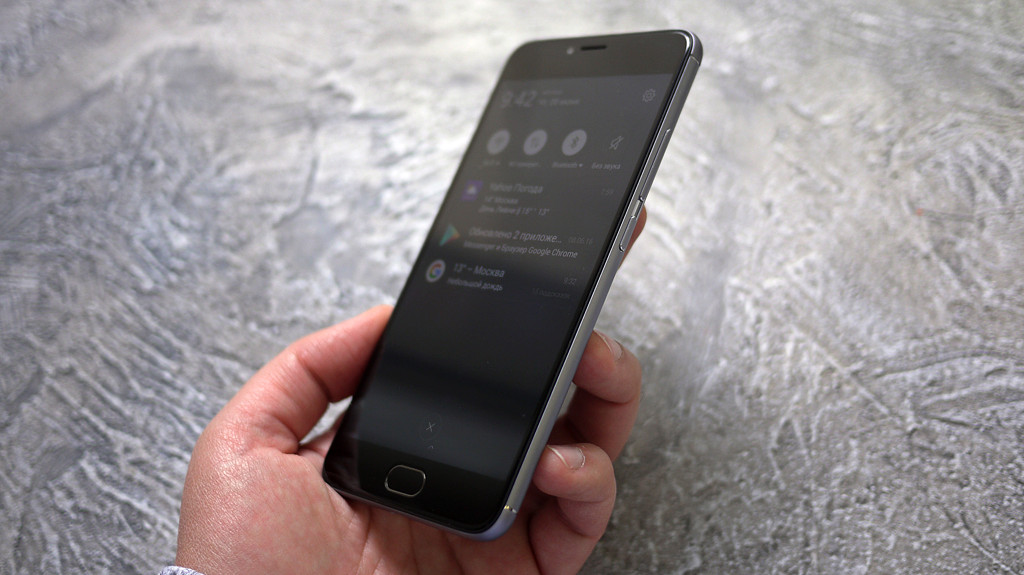
At the time of testing, two color options for the anodized coating of the M3 Note cases were offered for sale: silver (with a black or white front panel) and gray (with a black or white front panel).
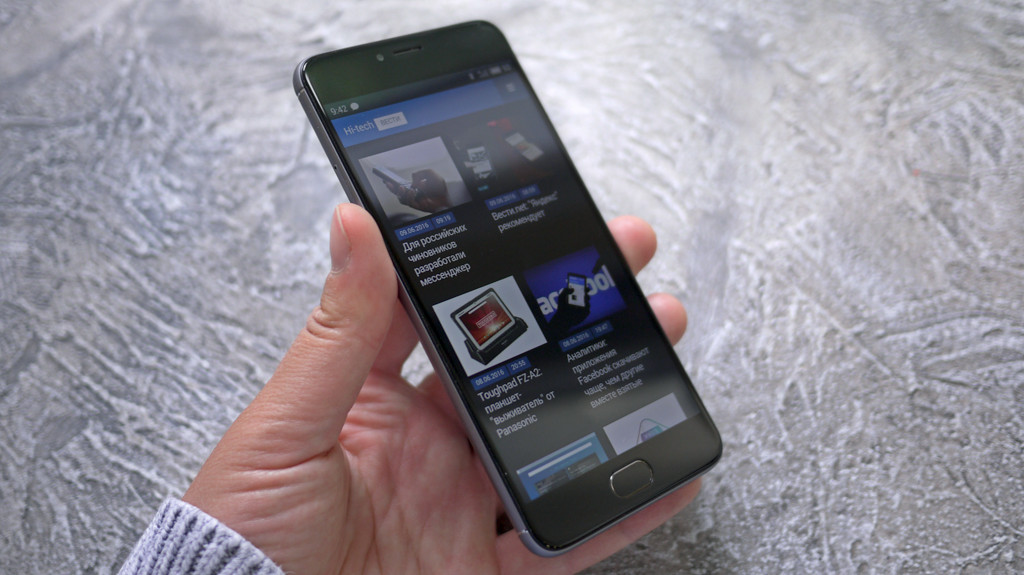
The entire front surface of the M2 Note, including the screen, is covered protective glass, which was chosen as Dinorex 2.5D T2X-1 from Nippon Electric Glass (NEG).
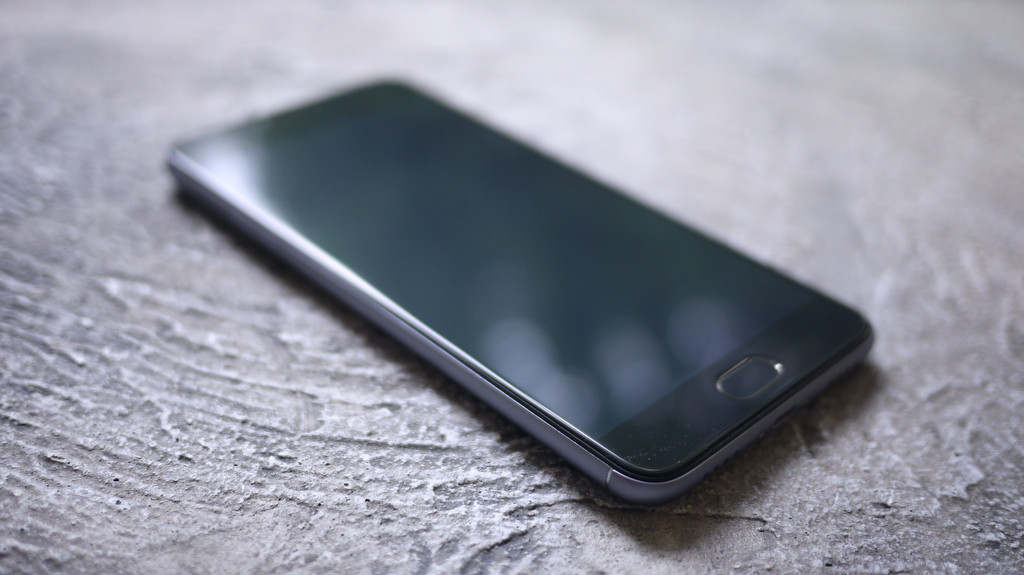
The 2.5D effect consists of a smooth “rounding” of this glass along the perimeter of the front panel.
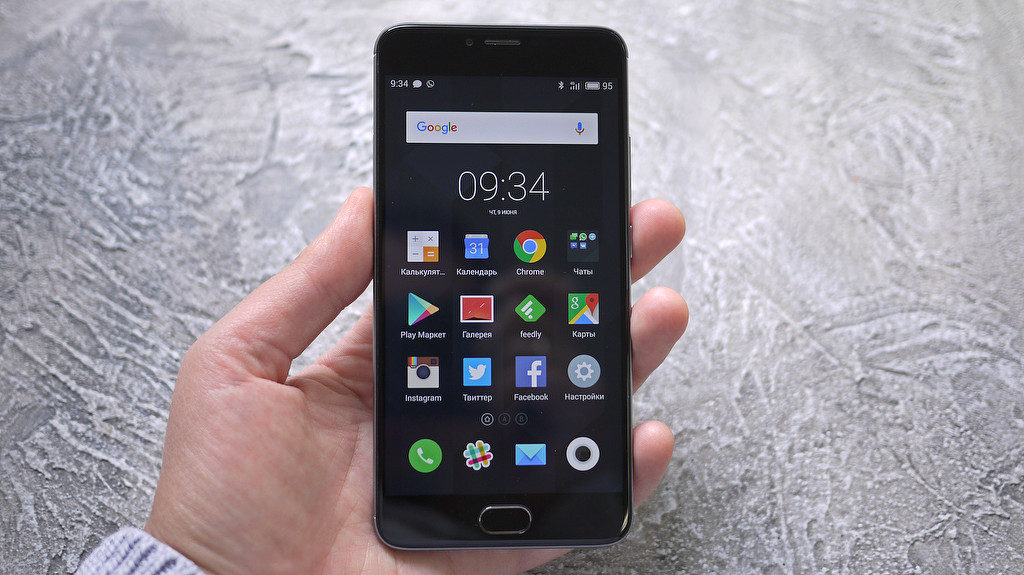
Above the display, with traditionally narrow side frames,
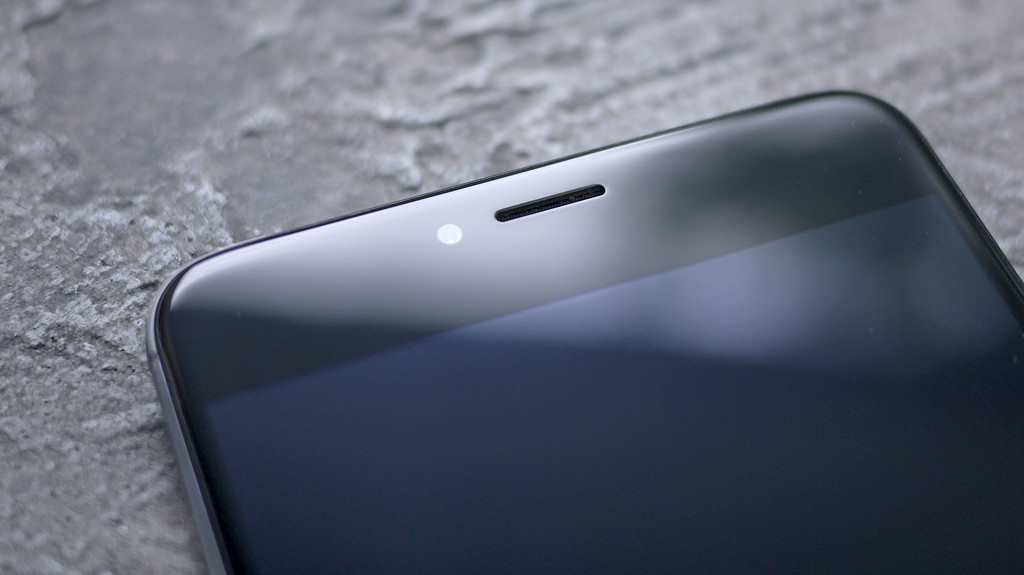
The speaker grille is located, surrounded by the front camera lens (on the left), light and proximity sensors, as well as LED indicator(right). The latter does not seem to be used by the standard smartphone tools.
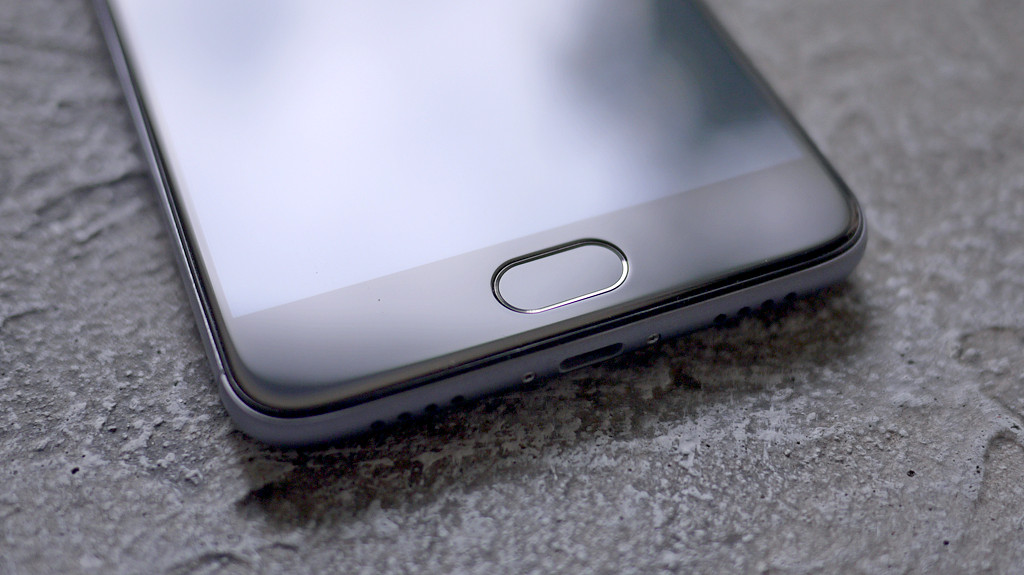
Below the display there is a mechanical key with a built-in fingerprint scanner mTouch 2.1, which looks very similar to mBack, which first appeared in a smartphone. From the latter it also inherited its basic functionality. So, a normal touch (tap) of this button activates the “Back” function, a short press with a hardware “click” returns to home screen(“Home”), and a long press (and hold) turns off the screen backlight. But the “Recent Applications” button is replaced by swiping up from the bottom edge of the display. After a short period of getting used to, this control scheme becomes very convenient.
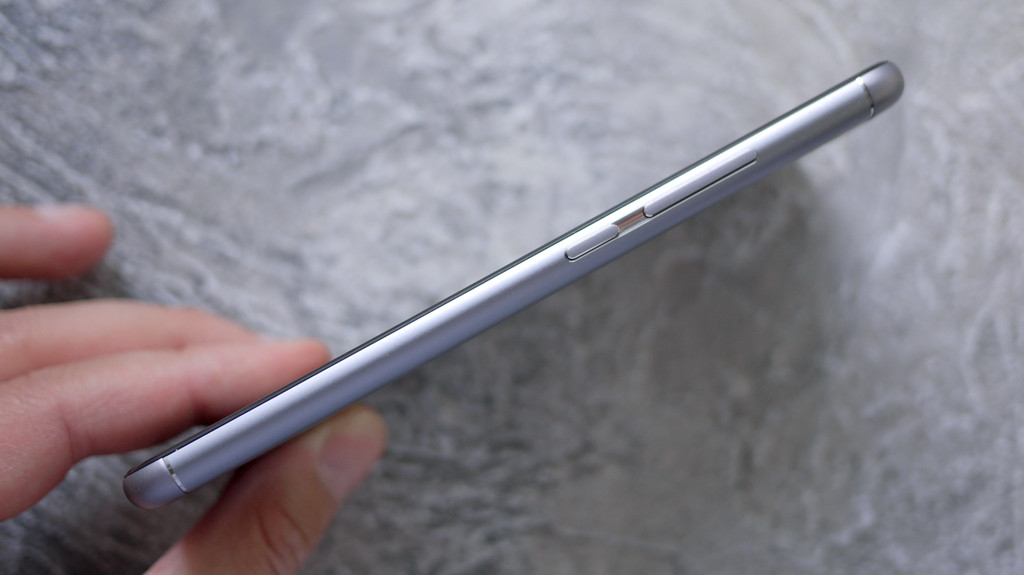
On the right edge, in a small recess, there is a volume rocker and a power/lock button.
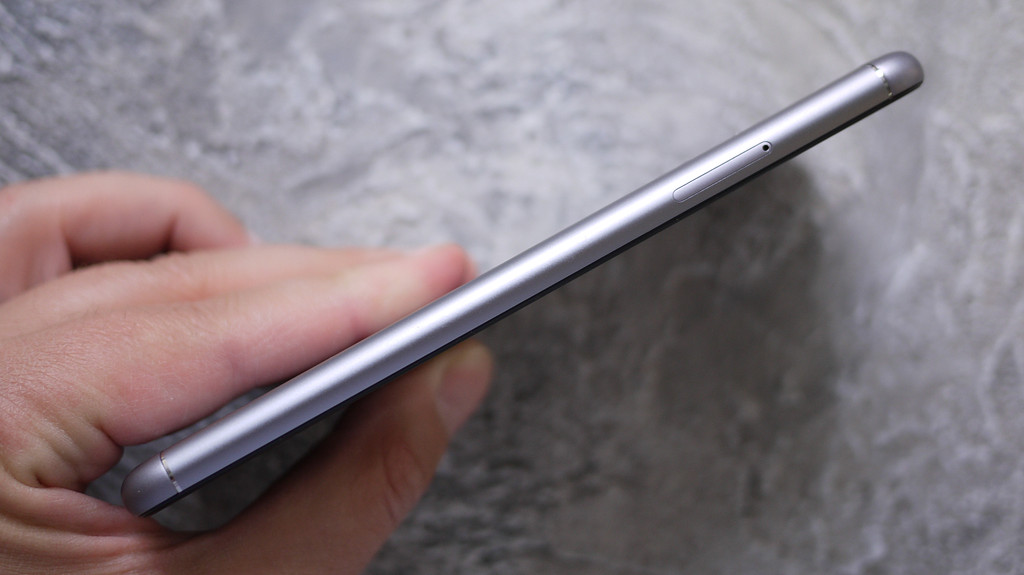
The left edge is occupied by a closed slot with a double tray, which can accommodate either two subscriber identification modules of the nanoSIM format, or the place of the second one will be taken by an expansion card microSD memory. To open the combination tray lock, you will need a special tool. As before, a thin paper clip can be used as it. Unfortunately, during the production of the device (at least our test unit), the size of the tray and the slot for it were not adjusted perfectly, as a result of which the tray rattles slightly if you shake the smartphone.
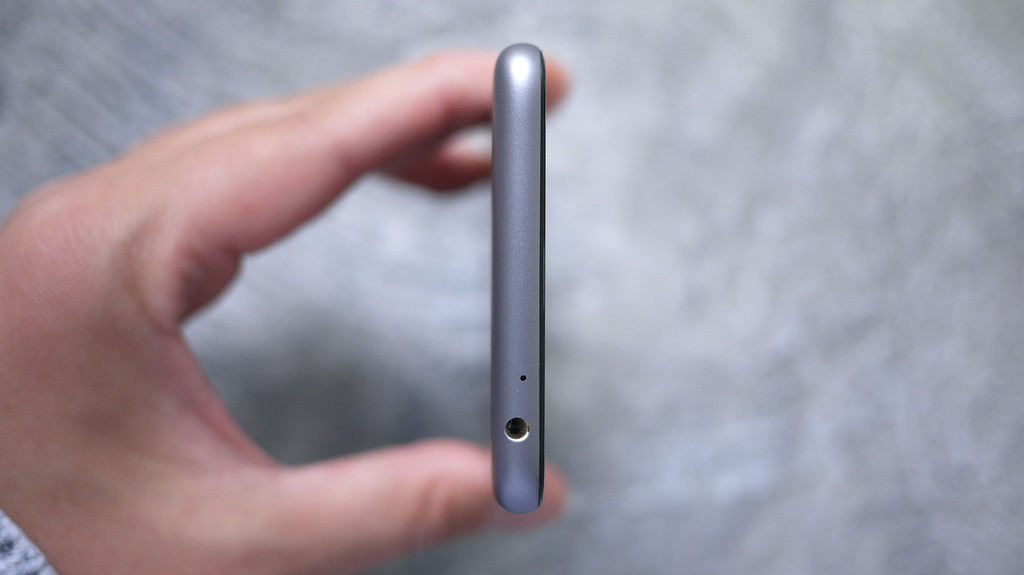
The hole for the second microphone (for noise reduction and sound recording) and the 3.5 mm audio headset connector remain on the top end.
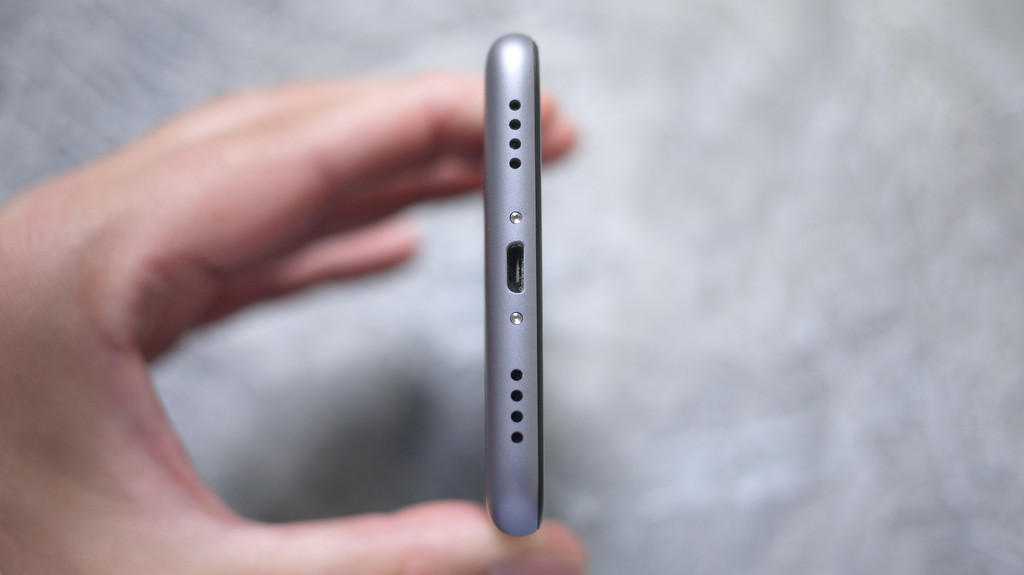
The microUSB connector between two mounting screws at the bottom end is framed by decorative grilles (four round holes in each). At the same time, a “conversational” microphone is hidden under the left, and a “multimedia” speaker is hidden under the right.

On the rear panel, the first thing that catches your eye are the relief strips separating the metal from the radio-transparent plastic,
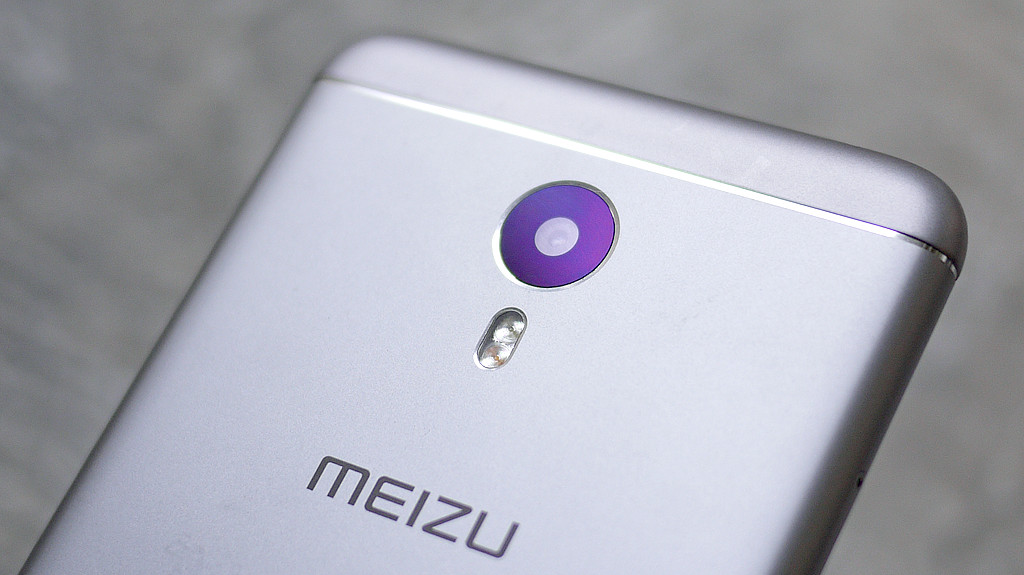
The front camera has a 5-megapixel BSI sensor (Samsung S5K5E8 or OmniVision OV5670 PureCel, 1/5-inch optical size) equipped with a wide-angle 4-lens lens with f/2.0 aperture. But autofocus and flash are missing here. Maximum size a picture in a classic proportion (4:3) - 2592x1944 pixels (5 MP).
Both cameras can record video in Full HD quality (1920x1080 pixels) with a frame rate of 30 fps, while the content is saved in MP4 container files (AVC - video, AAC - audio).
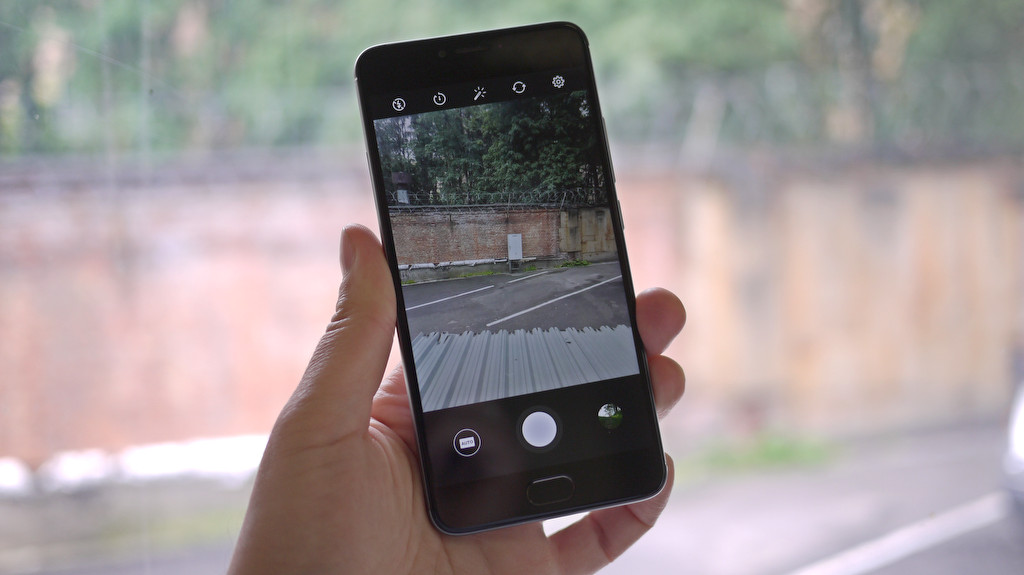
The interface of the Camera application in the M3 Note, compared to that of its predecessor, has been slightly improved, but the main capabilities have changed little. The modes “Auto”, “Manual”, “Portrait”, “Panorama”, “Change focus” and “Slow motion” (4 times, resolution 640x480 pixels, up to 60 minutes) remain in place. At the same time, having removed the “Scanner”, they added “Macro” and “GIF” (up to 6 minutes of animation). In the settings, you can select the HDR mode, as well as decide on the photo size and video quality. Shooting in manual mode(M) involves adjusting the parameters of shutter speed, ISO, exposure compensation, saturation, white balance, etc. By activating the appropriate option, focus and exposure can be measured separately. In addition, there are almost a dozen image filters at your disposal. It’s convenient to switch the viewfinder from the main camera to the front camera and back using vertical swipes. But the volume rocker (both increasing and decreasing) is also proposed to be used to release the shutter. The manufacturer notes the role of the ISP TrueBright image processor, which makes it possible to make pictures in low light brighter and clearer. However, even the main camera can hardly boast of special shooting quality in such conditions.
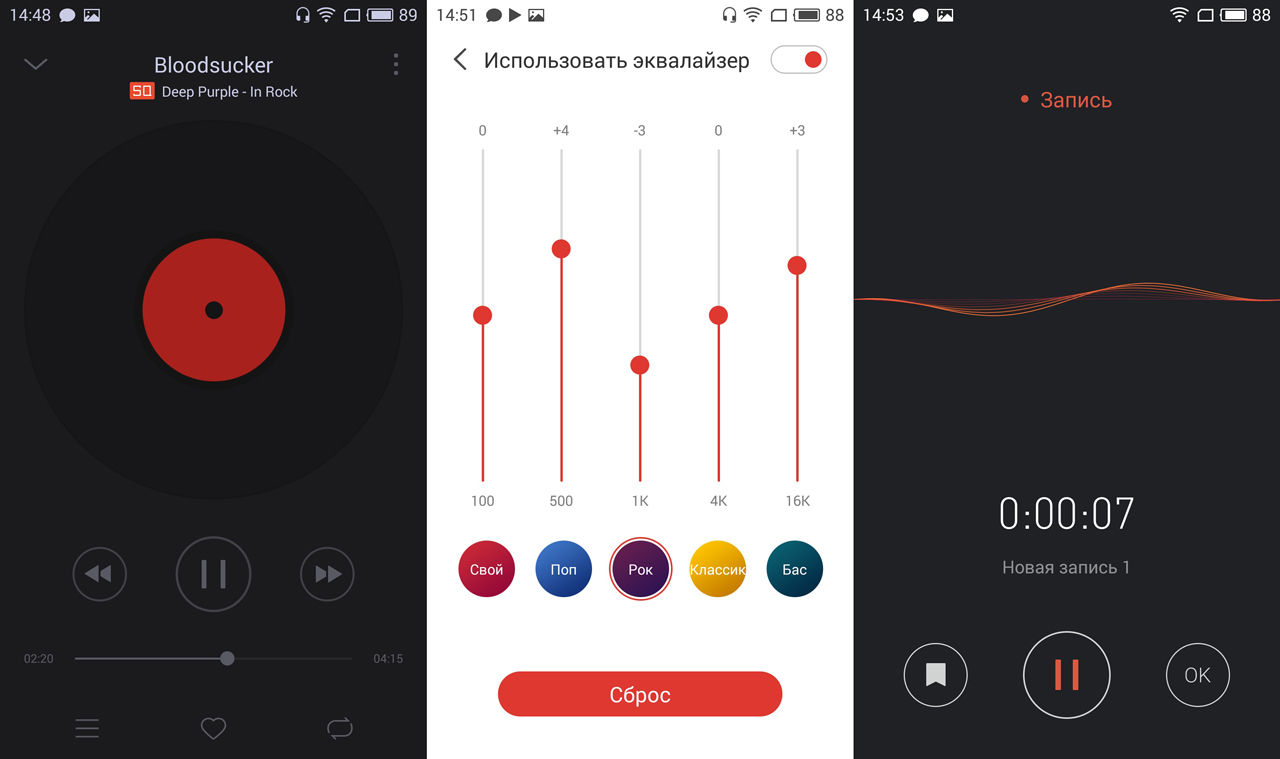
Not only in the placement of the “multimedia” speaker grille, but also in its acoustic capabilities, the M3 Note is practically no different from its predecessor. Established funds smartphones still allow you to listen sound files, for example, with FLAC extensions, created by codecs to compress audio data without losing quality. After connecting the audio headset, you are offered to use a 5-band equalizer with presets and manual setting. Unfortunately, the device does not have a built-in FM tuner. The simple "Dictaphone" makes fairly high-quality monophonic recordings (44.1 kHz), which it stores in MP3 files.
But with playing music via Bluetooth, a small problem emerged - clicks that occur when you take the smartphone in your hand or move it on the table. Apparently, the reason is insufficient shielding of the audio path from static electricity on the case.
Filling, performance
If they relied on the 64-bit MediaTek MT6753 platform with eight ARM Cortex-A53 cores (1.3 GHz), then for the M3 Note they chose the first-born from the MediaTek Helio P10 family of mid-range chipsets (aka MT6755), intended, according to the manufacturer , for thin smartphones.
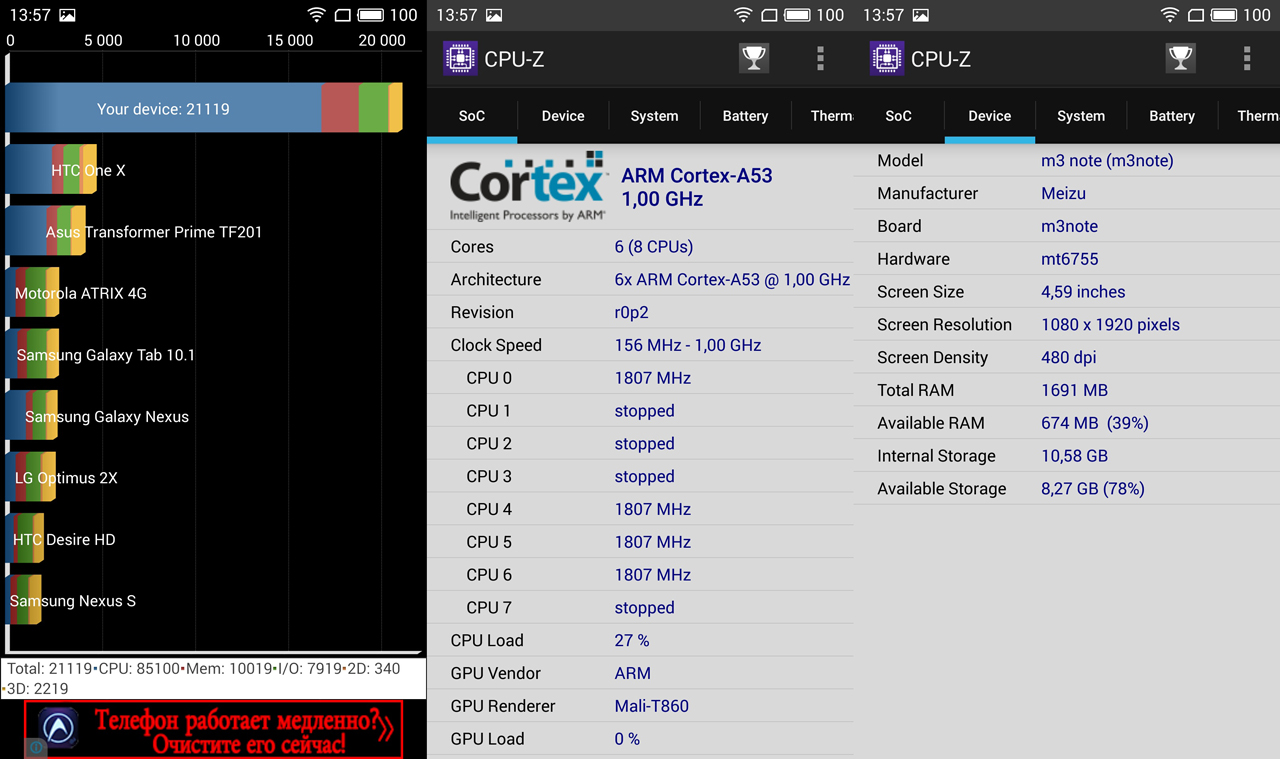
This chip is based on an 8-core processor, where four ARM Cortex-A53 cores are clocked at up to 1.8 GHz, and four more at up to 1.0 GHz. At the same time, the 2-core ARM Mali-T860 MP2 (550 MHz) architecture with support for OpenGL ES 3.2 and OpenCL 1.2 is used as a graphics accelerator. The MT6755 chip is made in a new way technological process TSMC 28HPC+ (28 nm), which, according to the manufacturer, reduced power consumption by 30-35% compared to chips manufactured in compliance with the “old” 28HPC design standards. In addition, increasing energy efficiency while maintaining sufficient computing power achieved automatic adjustment processor and video accelerator frequencies. Helio P10 can work in LTE-TDD, LTE-FDD Cat networks. 6 (300/50 Mbit/s), HSPA+, TD-SCDMA, EDGE, etc., and is also equipped with Bluetooth 4.0 LE and 2-band Wi-Fi interfaces. Among the other proprietary highlights of the MediaTek MT6755, in addition to MiraVision 2.0, it is worth noting the load optimizer for processor cores CorePilot and the heart rate monitoring system (using the camera built into the smartphone) Heart Rate Monitoring.
The basic configuration of the M3 Note is supplemented by LPDDR3 (933 MHz) RAM, which is controlled by a single-channel controller. Note that the smartphone variants with 16 GB or 32 GB of internal storage (eMMC 5.1) have 2 GB or 3 GB installed RAM, respectively. We received a device with a 2 GB/16 GB combination for testing. Judging by the published data, Helio P10 successfully competes with chipsets in performance Qualcomm Snapdragon 615/616, which does not contradict the results of the tests performed.
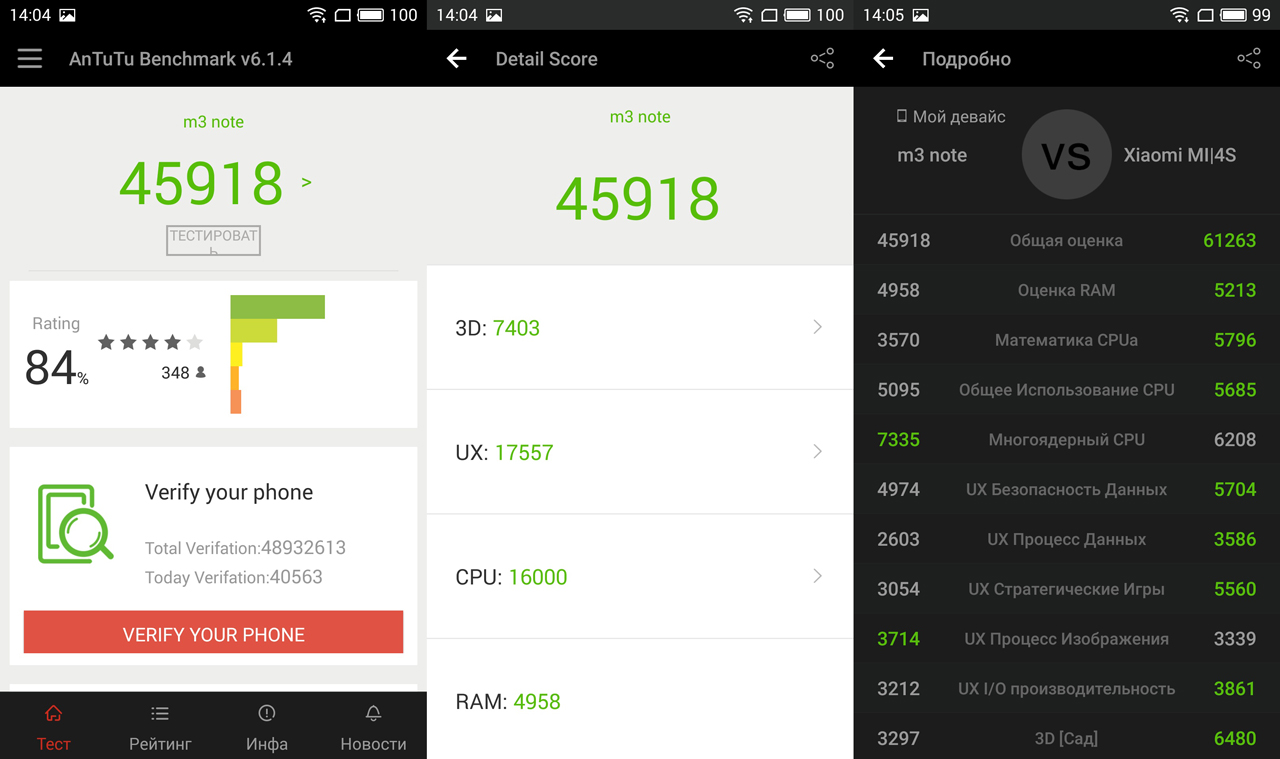
The number of “virtual parrots” obtained on the synthetic benchmark AnTuTu Benchmark was obviously predetermined by the selected hardware platform.
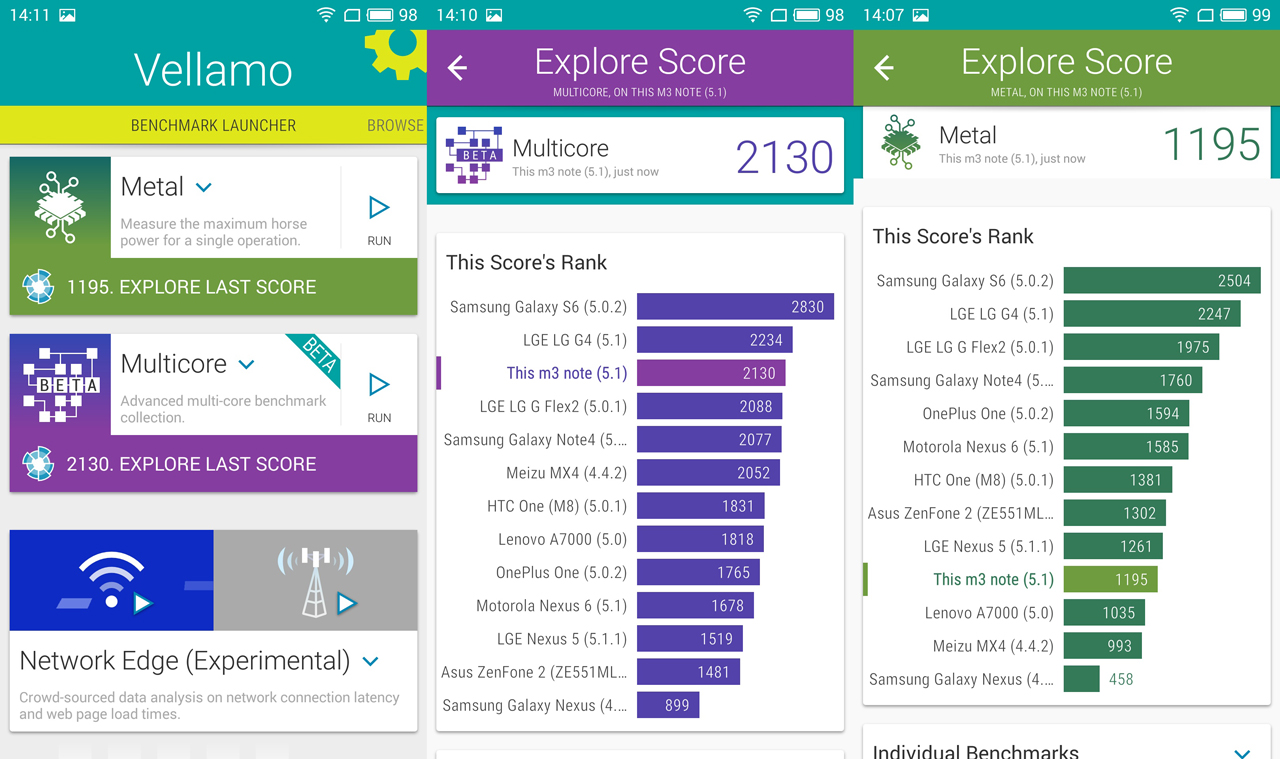
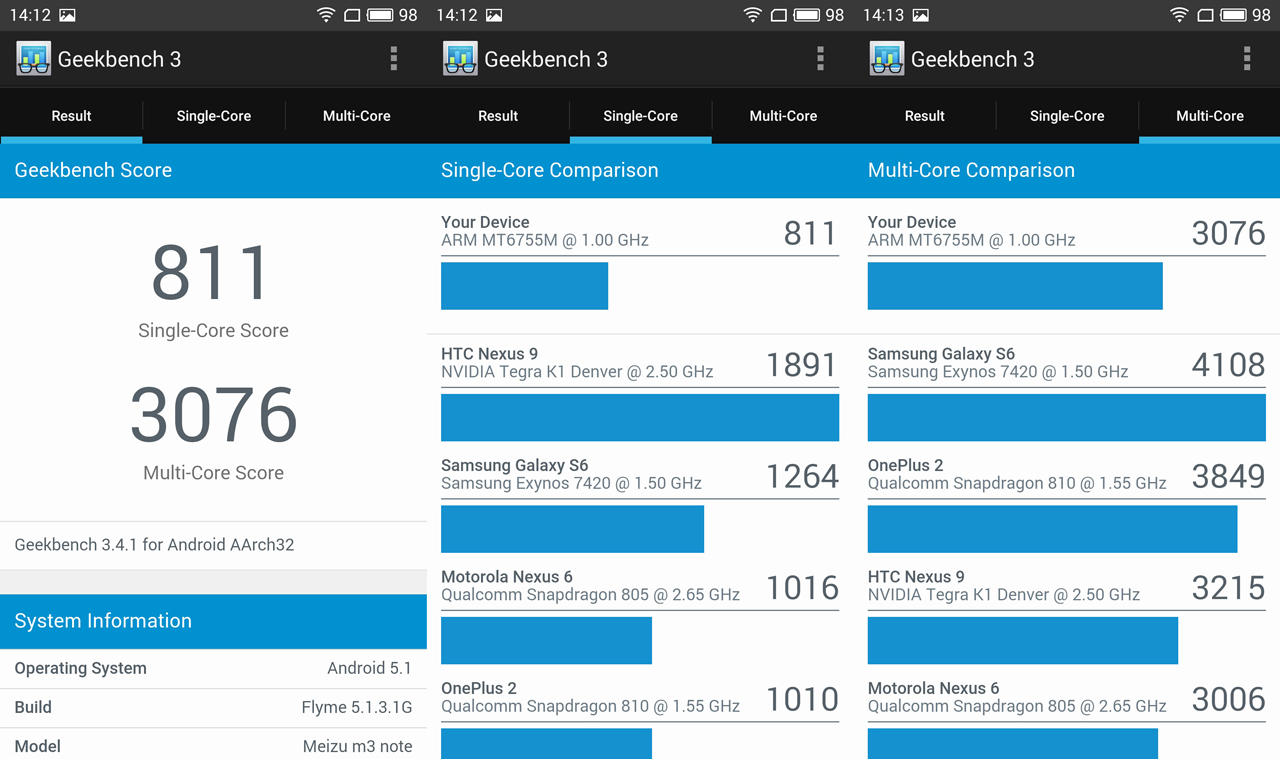
The efficiency of using the processor cores (Geekbench 3, Vellamo) of the new smartphone looks quite optimistic, but the estimate of the amount of “horsepower” is not so positive.
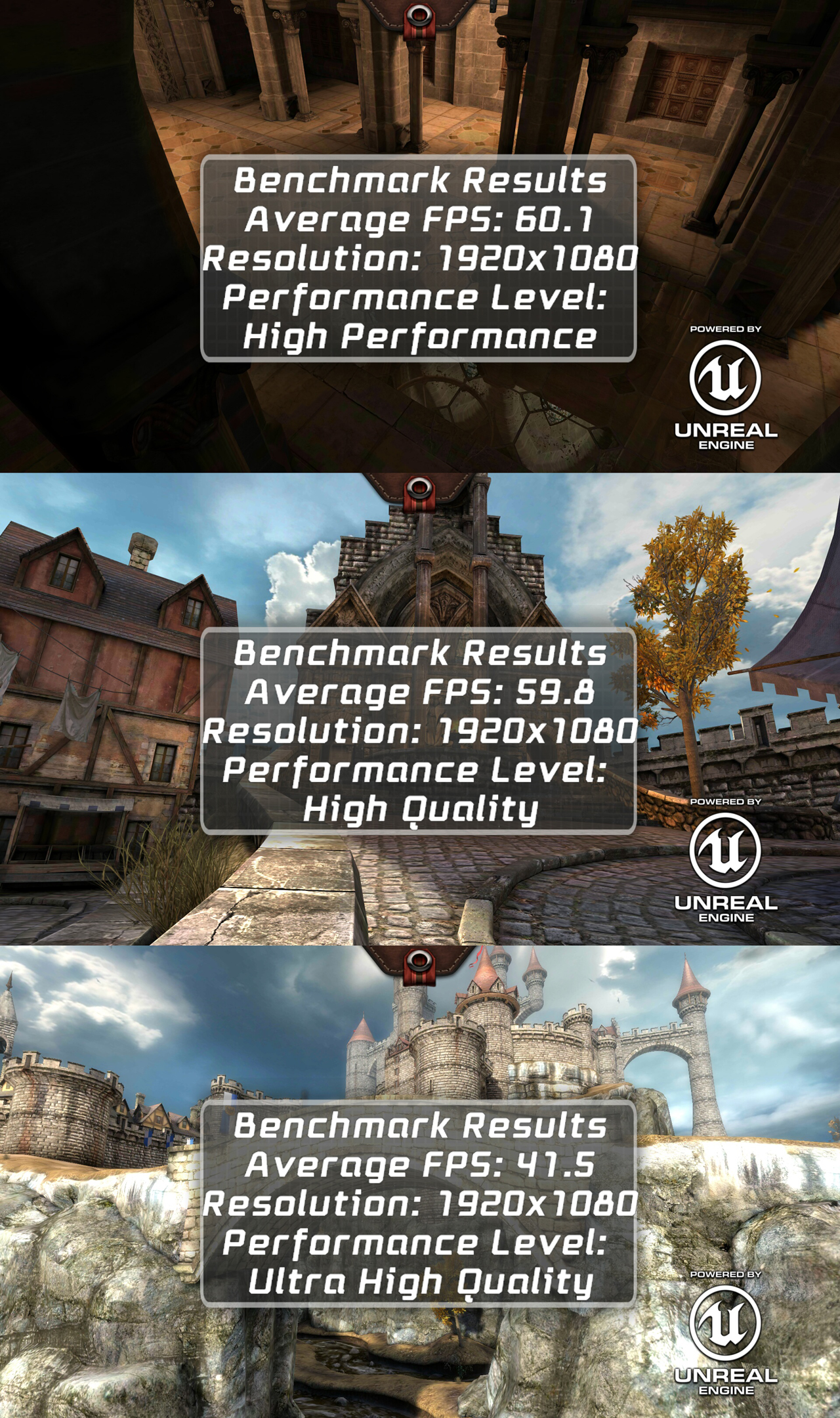
On the Epic Citadel visual test settings (High Performance, High Quality and Ultra High Quality), the average frame rate changed as follows - 60.1 fps, 59.8 fps and 41.5 fps, respectively.
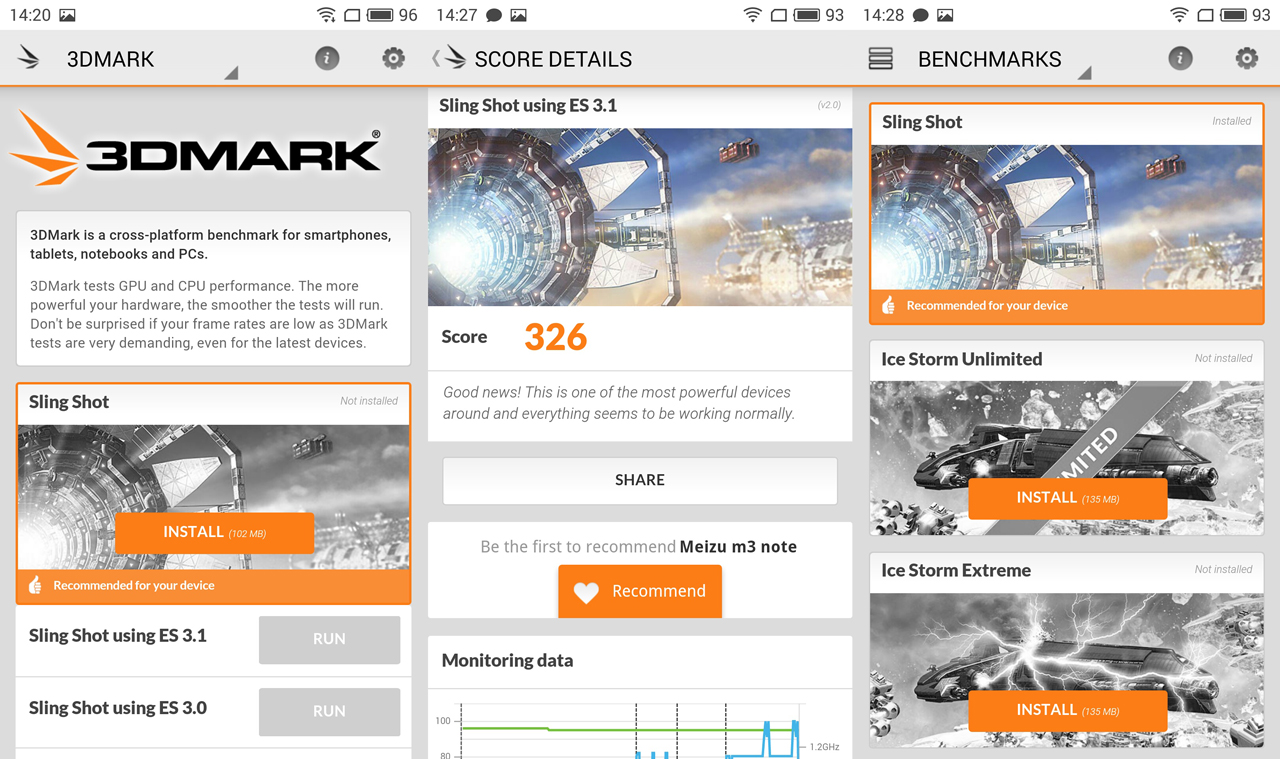
On the universal gaming benchmark 3DMark, where the Meizu M3 Note was tested on the recommended Sling Shot set (ES 3.1), a rather modest result of 326 points was recorded. If with simple games problems are unlikely to arise, then on “heavy” ones (Asphalt 8: Take Off, World of Tanks Blitz) it is better to limit yourself to medium settings.
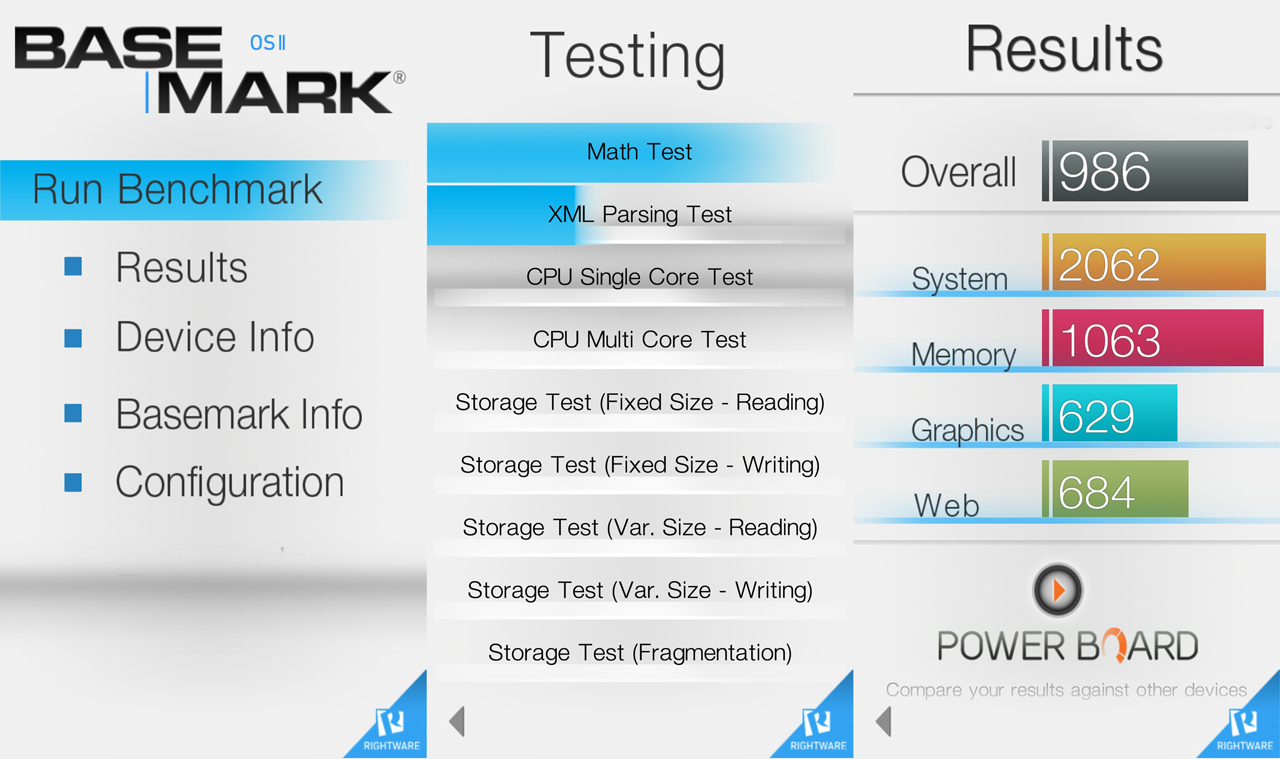
In turn, the total number of points scored by the smartphone on the cross-platform benchmark Base Mark OS II was 986.
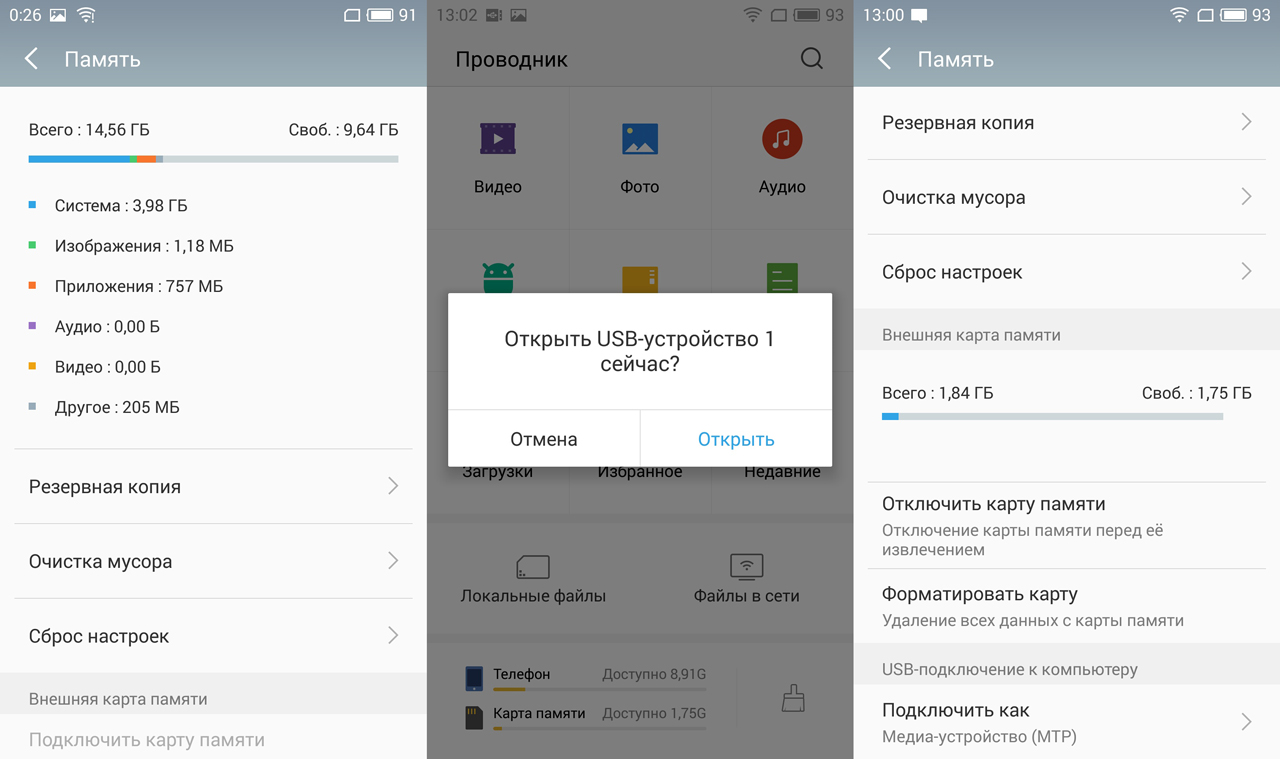
Of the 16 GB of declared internal memory in the tested model, about 14.56 GB are available, and approximately 9.6 GB are free. At the same time, like the , to expand the existing storage, it is possible to install a microSD/HC/XC memory card with a maximum capacity of up to 128 GB. True, the dual tray into which the memory card is inserted is universal, and if you take up one place in it, you will have to sacrifice the installation of a second SIM card (nanoSIM format). By the way, you can also expand the built-in memory thanks to the support of USB-OTG technology by connecting an external drive.
Similar to its predecessor, the M3 Note's set of wireless communications also includes a dual-band Wi-Fi module 802.11 a/b/g/n (2.4 and 5 GHz) and Bluetooth 4.0 (LE).
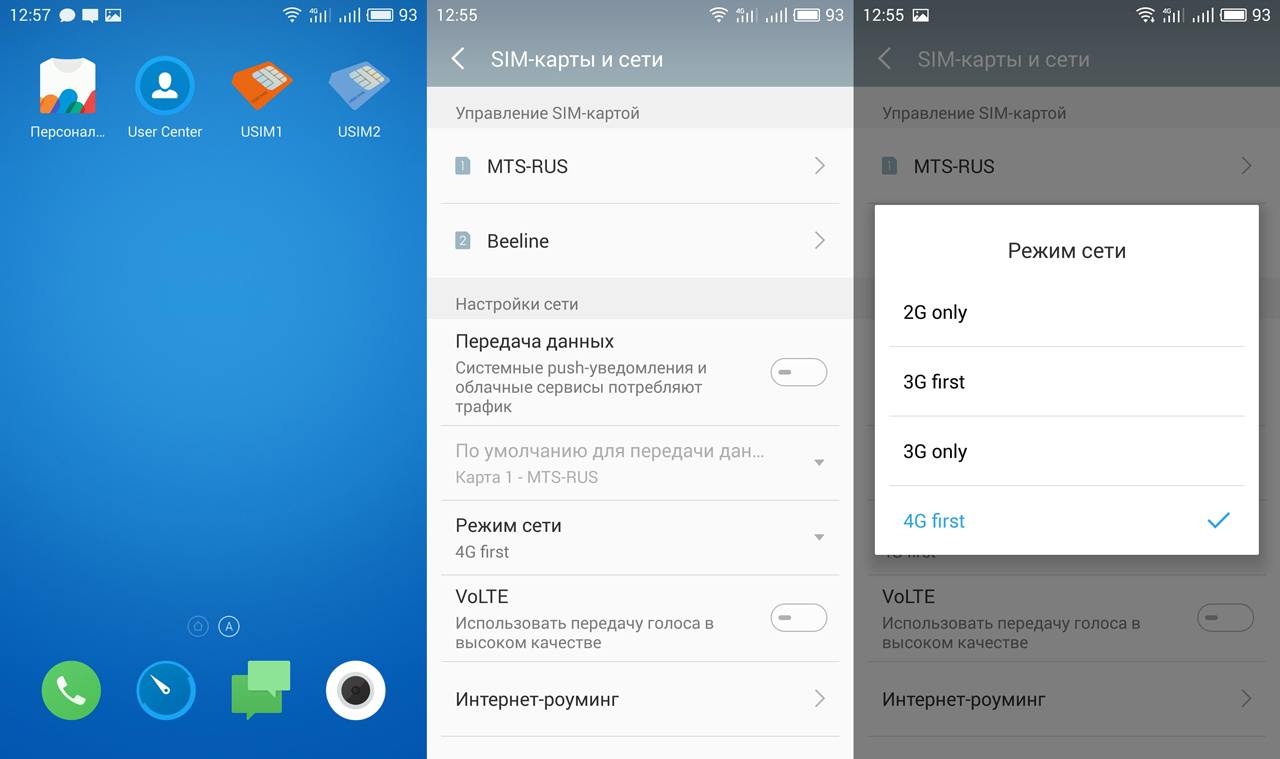
When two nanoSIM cards (4FF format) are installed, one radio channel of the device operates with them in Dual mode SIM Dual Standby, in other words, both SIM cards are active, but when one is busy, the other is also unavailable. Both trays in the slot support 4G, while the SIM card for data transfer, as well as the priority network mode, is selected in the corresponding menu. Unfortunately, only two “Russian” FDD-LTE bands are available - b3 (1,800 MHz) and b7 (2,600 MHz). But the most “punchy”, low-frequency b20 (800 MHz), as before, remained “overboard”. The manufacturer especially emphasizes support for the promising VoLTE (Voice over LTE) technology.
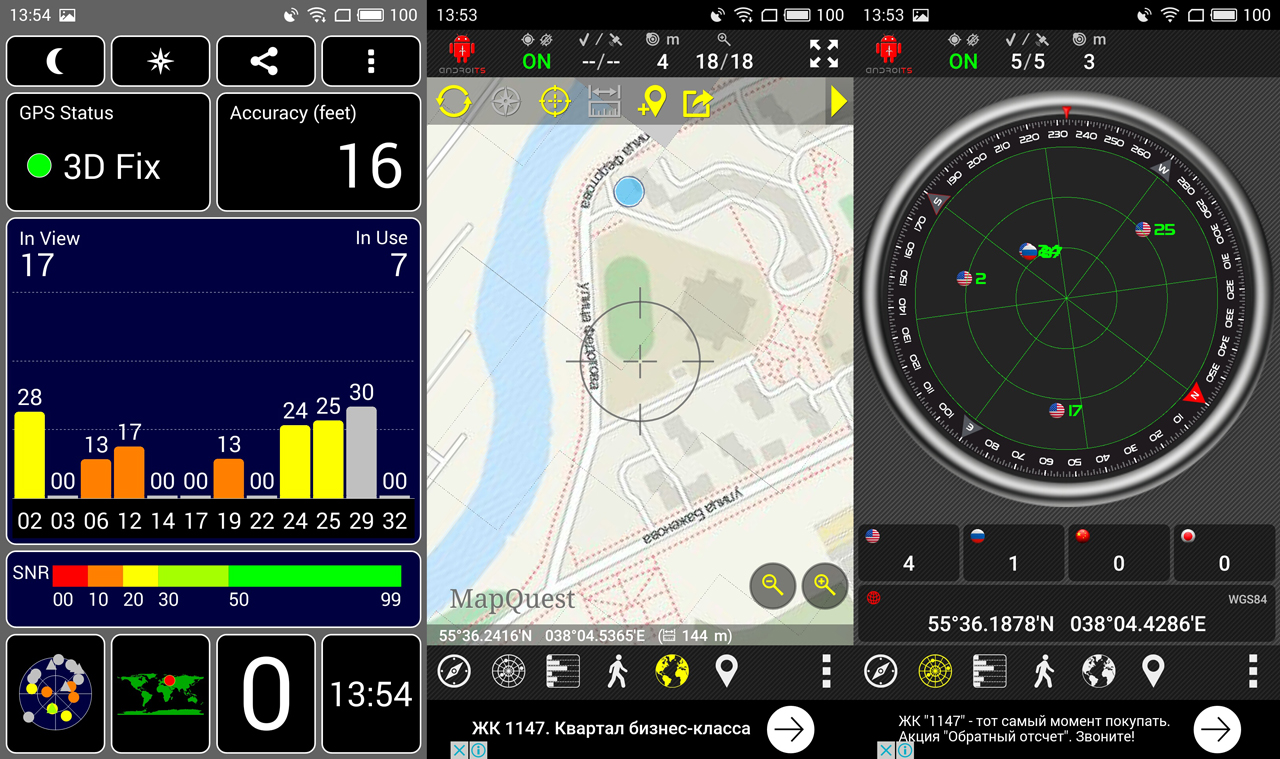
The built-in multi-system receiver uses GPS and GLONASS satellites for positioning and navigation, as confirmed by the results of the AndroiTS GPS Test and GPS Test programs. Support is also provided A-GPS technology(coordination over Wi-Fi and cellular networks).
Volume lithium polymer battery, which was equipped with the M3 Note (4,100 mA*h), compared to its predecessor (3,100 mA*h), increased quite significantly - by about 32% (1,000 mA*h). Despite this capacity reserve, the body of the new smartphone has become 0.5 mm thinner. Support fast charging not here. The smartphone comes with a power adapter (5 V/2 A). It will take about 2 hours to fill the battery to 100% from a level of 15-20%.
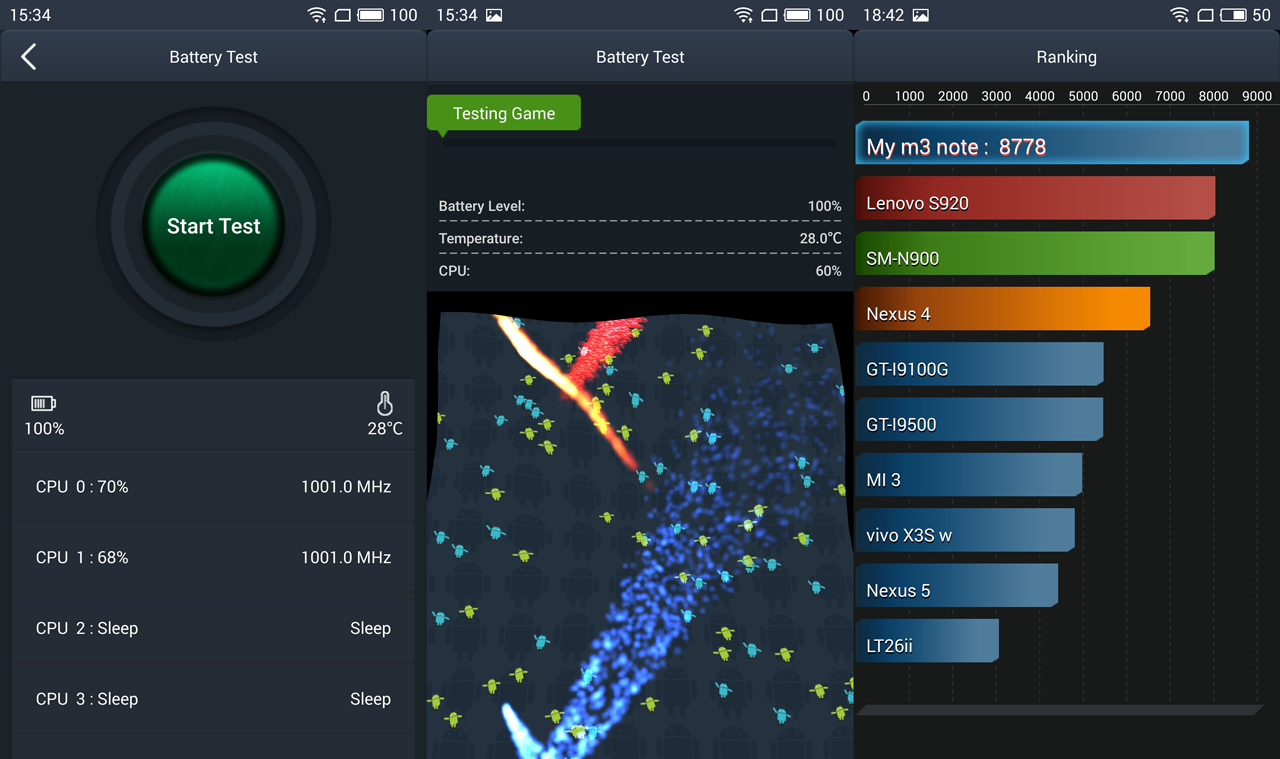
We managed to earn an impressive 8,778 points in the AnTuTu Tester battery tests. While here I was limited to 6,289 points. When the battery is 100% full, the manufacturer promises up to two days of operation. active mode, or up to 17 hours of video viewing, or up to 36 hours of listening to music. A test set of videos in MP4 format (hardware decoding) and Full HD quality at full brightness played continuously for almost 9.5 hours.

In the "Power Management" settings section, depending on the expected load, you can force the smartphone to switch from "Balanced" mode to "Energy Saving" or "Productive". In addition, the “Power Consumption Optimization” section suggests not only managing the sleep mode of applications, but also taking advantage of flexible settings to save battery power - “Smart”, “Super” and “Custom”.
Peculiarities software
The M3 Note smartphone runs operating system Android 5.1 (Lollipop), the interface of which is hidden under the proprietary Flyme OS 5.1.3.1G shell. It should be noted here that in latest versions Flyme firmware, including the above, first launch of the store Google applications Play (creation Google account) must be performed on a smartphone with a SIM card installed. This additional device authorization has become one of the new security requirements.
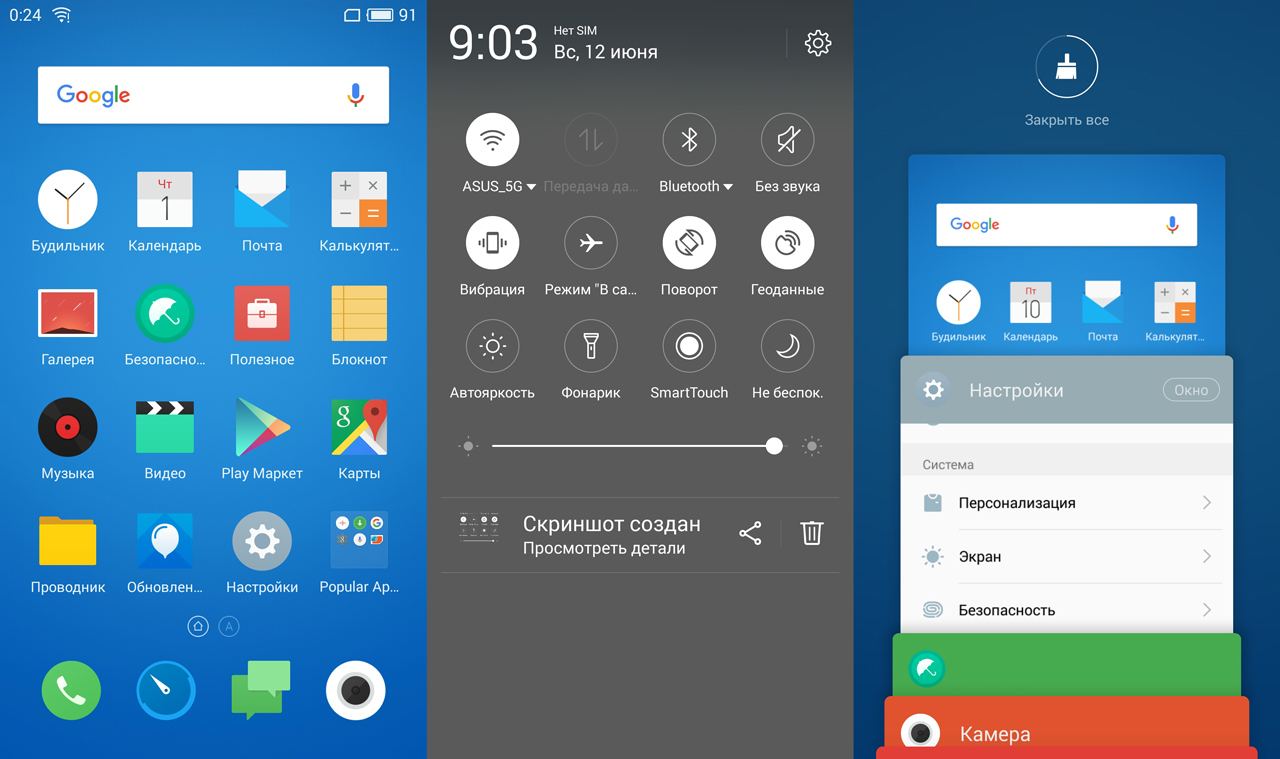
All program shortcuts, folders and widgets in the Flyme launcher are placed directly on the desktop. Swipe down to open the panel quick settings(where the brightness adjustment slider now appears), and swipe up to display recently opened applications.
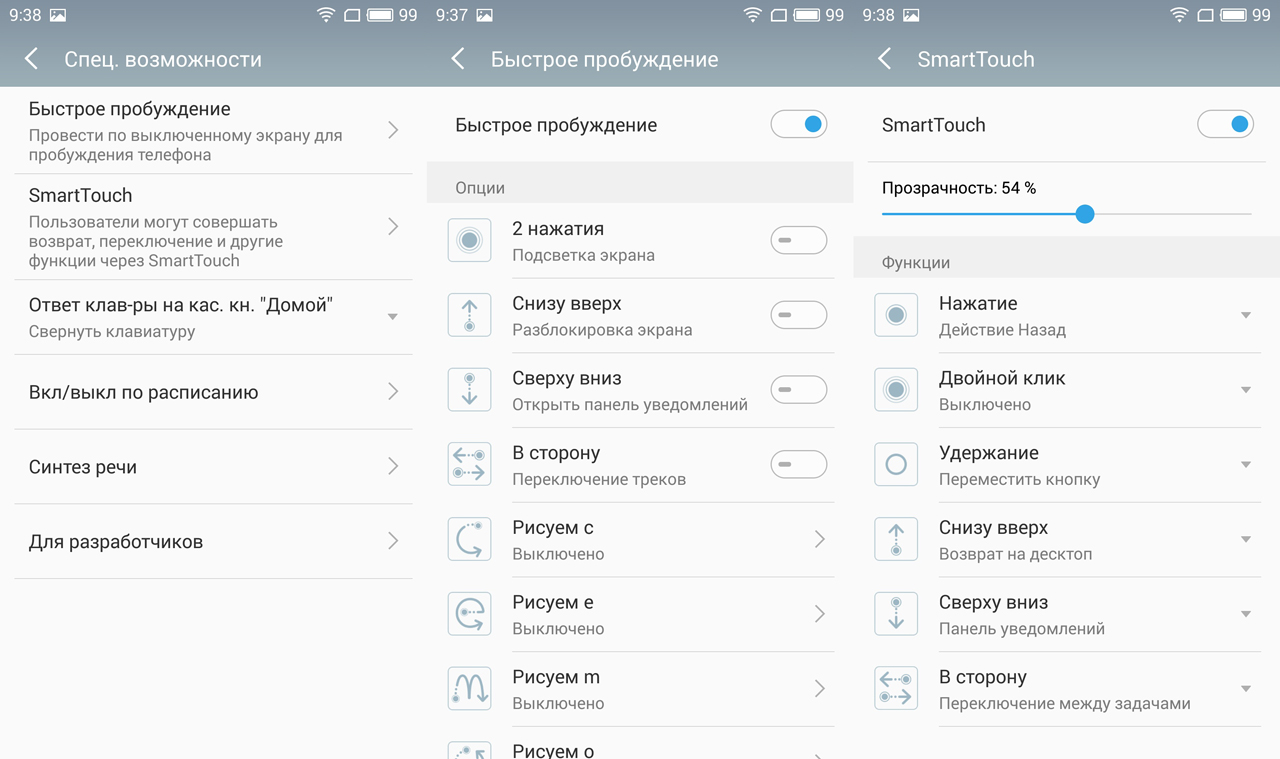
The “Special Features” section still contains possible smartphone control gestures, including the SmartTouch control “ring” (not shown in the screenshot) with adjustable transparency.

IN new version shell, it became possible to split the screen to simultaneously display the work of two applications, however, so far this only applies to the “Settings”, “Video” and “Maps” programs.
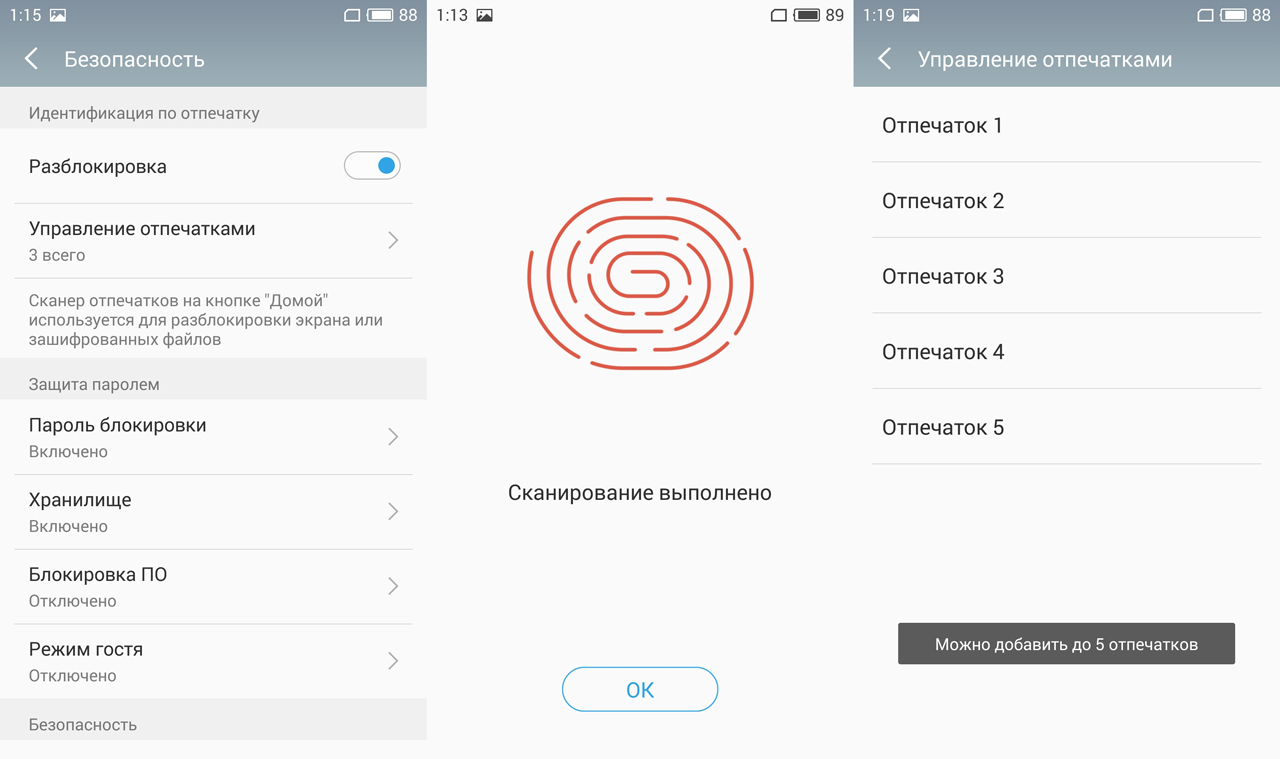
Using up to five fingerprints captured on the fast (0.2 second) mTouch 2.1 fingerprint scanner, you can lock not only the screen, but also access to files and applications.
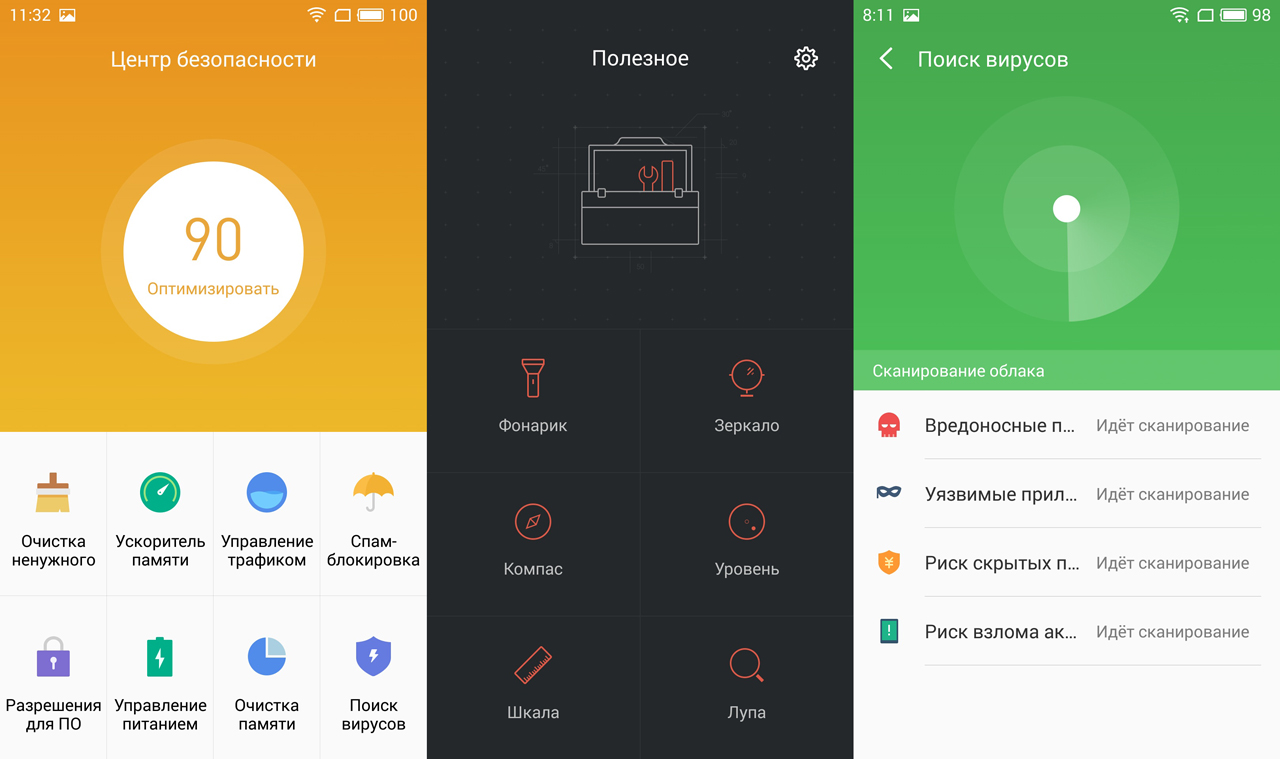
Installed on M3 Note minimum set software. From this software, you can highlight a collection of utilities for regular smartphone care, collected in the “Security Center” (virus scan, garbage removal, memory cleaning, energy saving management, etc.), as well as practical tools from the “Useful” application ( "Mirror", "Flashlight", "Ruler", etc.).
Purchase, conclusions
Improvements in Meizu M3 Note, compared to its predecessor, affected not only the replacement of plastic with aluminum alloy, but also the functionality of the filling. Now the smartphone, which can have 3 GB of RAM and 32 GB of internal memory, uses new processor, the battery capacity has increased significantly, and a fast fingerprint scanner has been added. In addition, both trays in the slot support not only LTE technology, but also VoLTE. At the same time, they managed to keep the price of the M3 Note quite attractive: 16,990 rubles for the 2 GB/16 GB version and 18,990 rubles for 3 GB/32 GB (RAM/internal memory, respectively).
Unfortunately, some of the predecessor's shortcomings migrated to new model. In particular, the 800 MHz LTE band was left out, the mandatory choice between a second SIM card and memory expansion remained, and the built-in FM tuner is still missing.
As for the closest competitors of the Meizu M3 Note, among them the one already certified for sale in Russia Xiaomi Redmi Note 3. No less metallic than the new product from Meizu, it has received more powerful processor, a 16-megapixel camera and a battery of almost the same capacity (4,000 mAh). At the same time, in large retail chains its 3 GB/32 GB configuration is priced at 17,990 rubles, and 2 GB/16 GB is another 2 thousand rubles cheaper.
Review results Meizu smartphone M3 Note
Pros:
- Attractive price
- High autonomy
- LTE and VoLTE support on both SIM trays
- Memory expandability
- Fast fingerprint scanner
Cons:
- Alternative installation of a second SIM card or memory card
- SIM tray is a bit wobbly
- Clicking noises when playing music via Bluetooth
- Lack of support for LTE Band 20 (800 MHz) frequency range
- No FM tuner
Meizu M3 Note review
This Meizu review M3 Note 32GB 2016 - a Chinese smartphone from the budget line of the now popular Asian brand.
It is noteworthy that this device incorporates the bulk of the solutions used in the company’s flagship, released a year earlier.
That is, at a relatively low cost (about 17 thousand rubles in Russia at the time of writing), the buyer receives a set of flagship technologies of 2015, many of which smartphones from famous brands still cannot boast of.
Specifications Meizu M3 Note
- Dimensions: height - 153.6 mm, width - 75.5 mm, thickness - 8.2 mm
- Weight - 163 grams
- Display - 5.5 inches with a resolution of 1920×1080
- Camera - main 13 MP and front (for video calling, selfies) 5 MP
- Processor - 8-core Helio P10
- RAM - 2 or 3 GB
- Graphics - Mali-T860MP2, 550 MHz
- Built-in memory - 32 GB
- Memory card support - microSD up to 128 GB
- Battery - 4,100 mAh
- Work in networks: 2G, 3G, 4G, LTE
- Number of SIM cards - 2 Nano-SIM
- Interfaces: Wi-Fi, Bluetooth, microUSB (for charging and transferring files), 3.5 mm audio jack for headphones
- Operating system - Android 5.1 with proprietary modifications
- Navigation - Glonass and A-GPS
- Equipment: fingerprint scanner, light and proximity sensors, accelerometer
Who is this smartphone suitable for? Everyone!
This universal device, covering most of the requirements that a modern city dweller of any gender and age places on a phablet.
The recently seemingly large 5.5 inches has already become an unspoken standard.
Meizu M3 Note perfectly copes with the tasks of a phone and instant messenger, takes excellent pictures, shoots videos with Full HD resolution and offers a lot of other features.
Design

Meizu M3 Note can be purchased in one of three colors:
with white front panel and gold back cover;
with white panel and silver cover;
with black panel and dark silver cover.
The price of the smartphone depends on the colors of the case.
There are no complaints about the appearance of the device: the smartphone is similar to the flagships of the same company released a year earlier - the MX5 and Pro 5 models.
Housing components are made from materials high quality: metal and glass.
There are plastic inserts only in the upper and lower parts of the case, but they are painted to look like metal and do not stand out.
But to make it clear what a phone is like in advanced games, you can turn to the popular “Tanks” today.
And here everything is not so rosy. In general, it’s possible to play, but it’s very difficult to call it a comfortable game.
Periodically gameplay“lags”, and the number of frames per second can drop to 16-17 fps (but also rise to 50). That is, the M3 Note is not suitable for gamers, or only at a stretch.
Battery
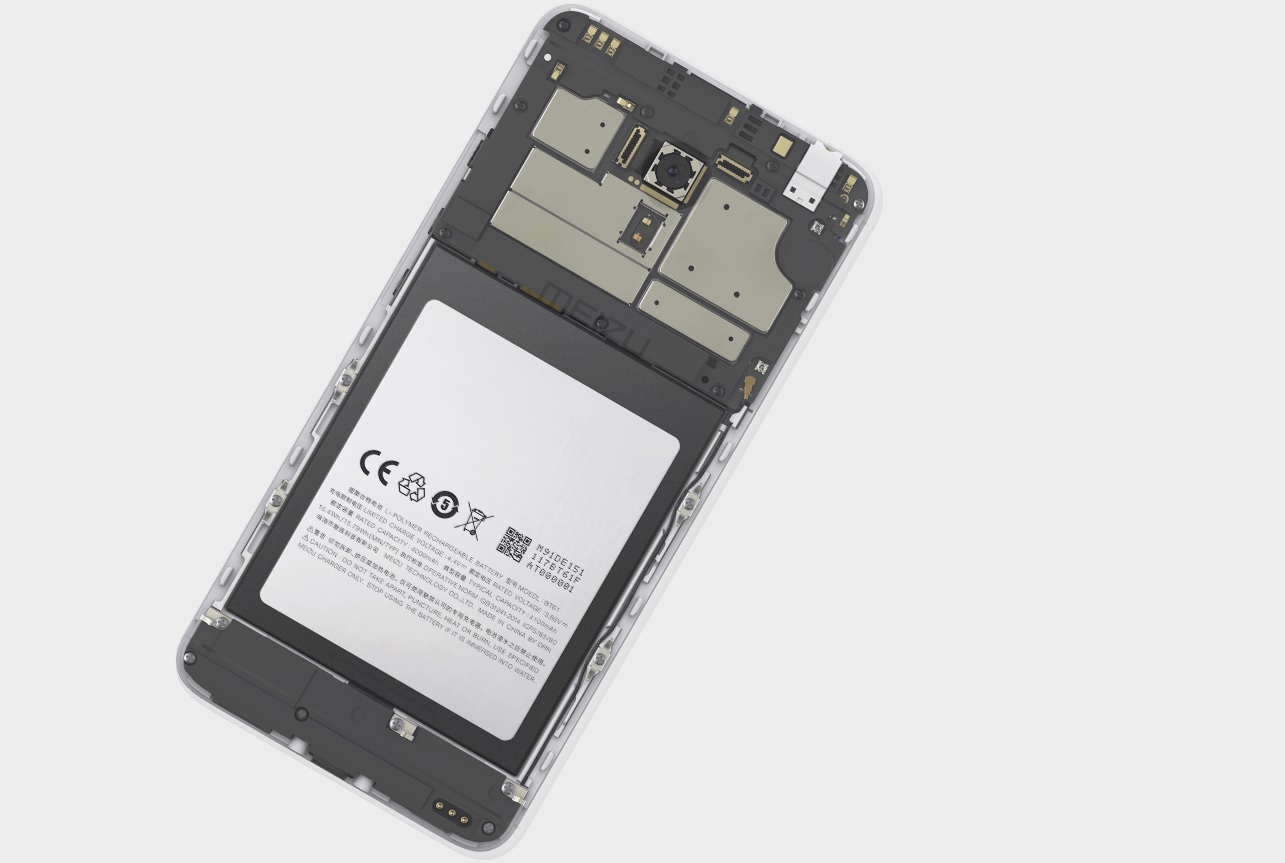
Battery Meizu M3 Note
The Meizu M3 Note smartphone is equipped with a capacity of 4,100 mAh, which, although not a record value, is very rare among devices of this type.
Taking into account the power of the device and decent amounts of electricity consumption, 4,100 mAh should be enough for two days active use smartphone.
This is quite a lot, considering the complaints of most owners of Android smartphones from other brands about discharge within one day.
The Meizu M3 Note will “live” much longer when used as a dialer and Wi-Fi is turned on only when necessary.
In continuous video viewing mode, the phone will work for up to 17 hours, and as a device for listening to music - up to 36 hours of sound without interruption.
It would not be an exaggeration to say that a capacious battery is the main feature of this model.
Fingerprint scanner

mTouch 2.1 - fingerprints in M3 Note. Its main feature is very fast work. It can determine the fingerprint of the smartphone owner in just 0.2 seconds.
Important: this fingerprint scanner can be used both as a means of unlocking the smartphone screen and as protecting access to certain applications from strangers.
Technological solutions

A review of the M3 Note wouldn't be complete without mentioning its features. motherboard smartphone.
Yes, it is hidden from view, but the developers of the device for its manufacture used flagship technology and made the board 10-layer!
This made it possible to more compactly fit all the components into a miniature area, and the “motherboard” itself turned out to be very durable.
This is a significant plus to protect your smartphone from possible damage.
Display
5.5-inch resolution Meizu screen M3 Note standard - Full HD, 1920 × 1080 pixels. This is enough to provide enough high density pixels - 400.5 dpi. There is no pixelation effect, watching movies and photos on the M3 Note screen is comfortable, as is reading; Both diagonal and resolution contribute to this.
The screen is made using LTPS technology, which is used for most IPS matrices used on top smartphones price category. Its viewing angles are quite wide - the contrast drops slightly, colors are distorted minimally. Looking at the display together is quite comfortable. The touch layer is responsive, it responds to touch quickly and accurately, supports up to ten simultaneous presses and easily detects gestures. The device can be used with loose gloves - the sensitivity of the touch layer allows it.
The manufacturer claims that the maximum brightness of the Meizu M3 Note screen is 450 nits. According to our measurements, the smartphone showed 422 cd/m2, which is close to the declared value. This is a fairly decent reserve of brightness; the device can be used under direct sun rays. Of course, there is all the necessary set of a polarizing filter, an oleophobic coating, and, of course, there is no air gap between the matrix and the glass. The minimum luminosity of the white field on the Meizu M3 Note screen is 14 cd/m2. It is quite comfortable to work with the device in the dark. The device is equipped with a light sensor - it can adjust the backlight level itself, and does so quite confidently.
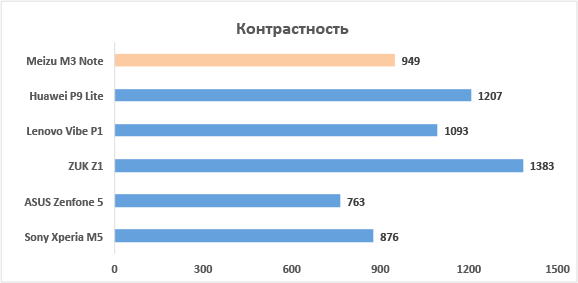
The static contrast ratio of the M3 Note display is not very high - 949:1. When close to maximum values brightness, the black color noticeably loses depth and becomes dark gray.

The white balance of the Meizu M3 Note screen is very good. The color temperature of shades of gray is on average 7250 K with a reference value of 6500 K. The difference is completely insignificant, you can safely close your eyes to it. For perfectionists, there is the possibility of manual adjustments color temperature in the settings.
The color rendition of the display is generally correct: all gamma curves - both gray and color components - are close to the standard. The exception is the slightly toned down blue spectrum. However, this is not at all critical.
The screen color gamut differs slightly from the sRGB reference color space.

The blue color at maximum brightness tends a little towards violet, green - into light green, and red - into reddish. However, only a special device sees this. “To the eye” it seems that everything is in order - the deviation is insignificant. The smartphone display is generally configured very well.
⇡ Hardware and performance
The smartphone is built on the MediaTek MT6755 Helio P10 platform. This is an interesting solution for middle-end devices, which includes eight ARM Cortex-A53 cores: four of them operate at a frequency of 1 GHz and four more at an increased frequency of 1.8 GHz. The platform was made using a 28-nanometer technological process.
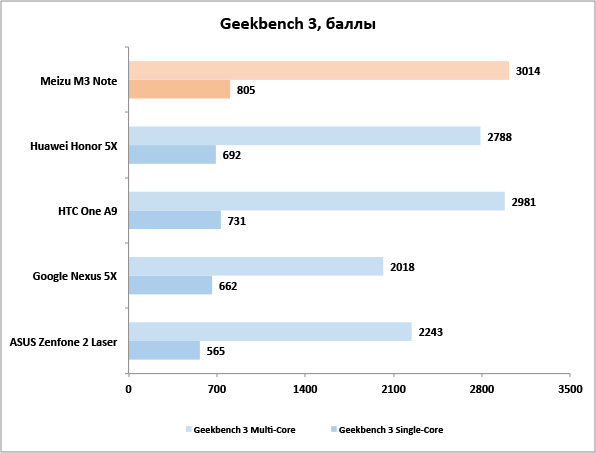
Despite the fact that you shouldn't expect anything special from the ARM Cortex-A53, in general synthetic tests Meizu M3 Note shows quite a decent level of performance. In the AnTuTu Benchmark 5.7 task, this device scored more than 37 thousand points - the result is good, plus or minus the same as that of its classmates.

There are two Meizu versions M3 Note - with two gigabytes of RAM and 16 GB of built-in flash memory or with 3 GB of RAM and 32 GB of flash. We received the younger version of the M3 Note for testing. Theoretically, the older one will receive slightly higher scores in the tests due to the larger amount of RAM. In practice, you can safely take the younger version in order to save a couple of thousand, because this difference will be within the margin of error, visible problems performance problems in most situations do not arise even with a two-gigabyte device; It makes sense to consider the older version only with some reserve for the future if you rarely change smartphones. You can install a memory card in Meizu M3 Note microSD format(for this you will have to sacrifice the second SIM), which reduces the advantages of the increased amount of built-in memory to nothing.
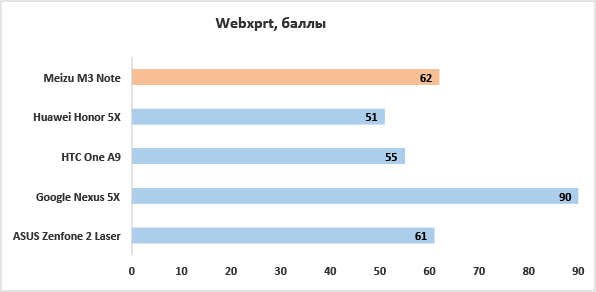
The device copes with everyday tasks very well: it is quite comfortable to surf the Internet, watch photos and videos, read electronic documents, play simple games. The smartphone works stably - during the test there was not a single critical freeze that could only be cured by rebooting. The animation of the operating system is displayed smoothly. By the way, this is due not only to a fairly powerful computing subsystem, but also to the remarkably optimized Meizu Flyme OS software shell. Working with a smartphone is pleasant.

The role of the graphics controller in the smartphone is played by the ARM Mali-T860MP2 module. This is not a very powerful solution: for fast and stable image rendering for Full HD screen it is suitable, but for resource-intensive toys - not so much.

However, you can still play heavy games on the Meizu M3 Note, but to do this you will have to reduce the graphics settings to a minimum and be tolerant of possible periodic drops in FPS. Be that as it may, the MediaTek Helio P10 platform was a pleasant surprise - for mid-price Android smartphones this is a very interesting solution.
![]()
⇡ Communications and wireless interfaces
The smartphone can work with two SIM cards. But, as often happens, there is no separate slot for a second SIM card - only a combined slot for microSD/nano-SIM. That is, the user has to choose: either extra gigabytes, or flexibility in communication tariffs. This imposes some restrictions - I would, of course, like to see full three connectors for all cards in the device. Will they really be useful? end user or not is a secondary question. Talking on Meizu M3 Note is quite comfortable: the quality of signal reception cellular network We have no complaints. Volume reserve conversational dynamics decent - the interlocutor can be clearly heard even in noisy places. Device supports LTE standard Cat. 6 - maximum theoretical data reception speed through mobile internet is 300 Mbit/s, upload - 50 Mbit/s.

The device has Bluetooth modules and Wi-Fi, but, as regularly happens with Chinese gadgets, there is no NFC. Not to mention the infrared port. And if the latter is not due to its status, then support for Near Field Communication should be here - this is a critical drawback. The existing modules work quite stably, without failures. The gadget quickly connects not only to home, but also to public access points and continues to exchange data with them at a decent speed, even when away from the router.
The device navigates the terrain quite quickly. The device has a radio module installed that can communicate with GPS satellites(with A-GPS support) and GLONASS. A few seconds after launching the profile test, the device detected 10-11 satellites of two navigation systems in total and was guided by 8-9 of them. The navigation error radius was quite insignificant - about four meters.
⇡ Camera
The set of cameras in the device is quite expected for a smartphone of this class. The front camera here is five megapixel, without autofocus and flash. Nevertheless, it is notable for its relatively fast lens - f/2.0. Thanks to this, you can take selfies and talk with video even in a not very well-lit room. Of course, the picture will contain noise and other artifacts, but the image will at least be readable and understandable for the interlocutor - and this is already important.

The rear camera in Meizu M3 Note has a 13-megapixel sensor. It features an autofocus system and dual LED flash to help avoid cadaverous skin tones when shooting in the dark. The lens here is five-element, with a maximum aperture f ⇡ Autonomous operation
An important advantage of the Meizu M3 Note is the presence of a rather “fat” battery, so to speak. The smartphone has a battery capacity of 15.58 Wh (4100 mAh, 3.8 V). It’s no wonder that the device consistently survived until the end of the working day during testing, with another 20-40% charge remaining, depending on the intensity of use. With moderate activity, the gadget can work away from a power outlet for two days. At the same time, for a full charging cycle using the included charger takes approximately three and a half hours. You can extend the life of the battery by customizing energy saving algorithms - there are quite a few of them in Flyme OS.
|
|
|
|
||
|
Meizu M3 Note - power saving options |
||||
During continuous playback of HD video with internal memory, at maximum display brightness, with an active Wi-Fi connection and data updating in background, the device worked for more than ten hours! The result is excellent. The battery of Meizu M3 Note is enough to watch your favorite series episode after episode during a long flight, without even being distracted by lunch.

⇡ Conclusion
Meizu M3 Note is a very good, but not uncontested device. It fits well with the concept of Meizu, which offers for relatively little money not only a serious set of characteristics, as we are already accustomed to Chinese smartphones, but also the quality of execution. Metal body, 2.5D glass, neat design, fast shell - yes, the device has very serious competitors in the form of Honor or Huawei, but Meizu offers a very adequate alternative. If you are looking for a smartphone with a large screen at a price below 20 thousand rubles, you can and should consider the M3 Note. It is worth saying that there are problems with the acquisition and support of Meizu in the territory Russian Federation it won’t - smartphones are shipped here officially.
AdvantagesMeizu M3 Note:
- Anodized magnesium aluminum alloy body, nice design;
- presence of a fingerprint scanner with the ability to restrict access to files;
- ability to work with two SIM cards;
- long battery life;
- pleasant and well-optimized Flyme OS software shell.
FlawsMeizu M3 Note:
- the body dimensions could be a little smaller;
- lack of a separate slot for a second SIM;
- lack of Near Field Communication (NFC);
- Average main camera.
Beautiful…
The Meizu brand is one of the most popular Chinese smartphone manufacturers at the moment. The company produces truly reliable, beautiful and well-balanced gadgets.
Budget…
The company has a line of budget devices of the company, which in the Chinese market is separated into a separate sub-brand - Meilan ("Meilan"), also known as Blue Charm ("Blue Charm"). But for the international market they are simply called Meizu M1,2,3, etc.
Big…
Note (“Note” or, if you prefer, “Note”) in the names of the models indicates that they are equipped with large 5.5-inch screens with FullHD resolution.
We will now take a closer look at one of these beautiful large budget employees.
- Screen: 5.5 inches, FullHD (1920x1080 pixels), 2.5D glass, Dinorex T2X-1 protection.
- Chipset: MediaTek Helio P10 (MT6755M).
- Processor: ARM Cortex-A53 (64-bit, 8-core – 4x 1.8 GHz + 4x 1 GHz).
- Video processor: ARM Mali-T860 MP2 (2-core, 700 MHz).
- RAM: 2 GB.
- Built-in memory: 16 GB (using micro-SD it is possible to increase up to 128 GB).
- Number of SIM cards: 2.
- Type: nano-SIM(2x nano-SIM or nano-SIM + micro-SD).
- SIM card operating mode: alternating.
- Standards cellular communications: 2G/3G/4G (including VoLTE)
- Wireless standards: Wi-Fi (802.11a/b/g/n, 2.4/5 GHz), Bluetooth (4.0).
- Navigation: GLONASS/GPS/.
- Interfaces: micro-USB USB standard 2.0 (USB-OTG, USB-host), 3.5 mm for headset.
- Main camera: 13 megapixels (dual LED flash, fast autofocus, Corning Gorilla Glass 3 protection).
- Front camera: 5 megapixels.
- Operating system: Flyme OS (on Android based Lollipop version 5.1).
- Sensors: gyroscope, accelerometer, Light sensor, IR proximity sensor, magnetometer, orientation/rotation sensor, fingerprint scanner, Hall sensor.
- Battery: lithium polymer (Li-Pol), non-removable, 4100 mAh.
- Housing: Aluminum alloy with plastic inserts, glass
- Dimensions: 76x154x8.2 mm.
- Weight: 163 g.
- Year of release: 2016.
The company offers a choice of two versions - Meizu M3 Note 16Gb and Meizu M3 Note 32Gb. The devices differ only in the amount of RAM and built-in memory on board - in the second version, 3 GB and 32 GB are installed, respectively. Otherwise, the characteristics are completely identical. The price difference between these two versions is minimal, so there's no need to skimp on performance or capacity.
Appearance
Externally, the case resembles older premium models – MX5 and Pro 5, which in turn are very similar to the 6 Apple. And this is not surprising - the company has long been positioned among buyers as a high-quality Apple imitator.
The body is made of aluminum-magnesium alloy with small plastic inserts on the back side (top and bottom) so as not to shield the antennas with metal. They differ in color from the body by half a tone, but this is almost not noticeable.
The phone is in hand, despite its size, lies well and comfortably. The combination of an (almost) all-metal streamlined body, rounded corners and 2.5D glass front panel makes appearance not only superbly elegant, but also very comfortable to use and provides a pleasant tactile sensation to the owner. Prints on back cover almost invisible.
Three colors available – dark grey, gold and silver (light grey). The front panel is presented in two color options - white or black.
Connectors and controls
On the front side in the center at the top there is a speaker, to the left of him - front camera, and on the right there is a proximity sensor (infrared), a light sensor and a notification indicator.
At the bottom, under the screen, There is a wonderful multifunctional control key. This key is both mechanical and touch, and at the same time it is an mTouch 2.1 fingerprint scanner!
A description of the capabilities and functions of this key will be below. We will mention only one “feature” right away, since they write a lot about it on the Internet. YES, this key is indeed set somewhat crookedly from the factory! Although this is practically unnoticeable, it can still spoil the impression for someone.
On the reverse side - the main camera is located in the top center, and below it is a dual two-tone LED flash. Below them is a stylized company logo. For those who are critical, let us inform you that the camera does not protrude, but is even somewhat recessed into the body.
The lower end is occupied by: micro-USB connector - in the center, the multimedia speaker is on the right, and the conversation microphone is on the left side. A 3.5 mm headset jack and a microphone for noise reduction and sound recording are located on the upper end on the left side. On the right edge of the smartphone, in a small recess, there are standard buttons: power/lock and volume control.
On the left side there is a closed tray for a nano-SIM card and expansion cards microSD memory(or for the second nano-SIM). Both SIM slots support 4G, but not at the same time! You can specify in the settings which SIM card will work in 4G/3G mode, while the second will only have 2G mode.
Screen
FullHD screen with a resolution of 1920×1080 and 5.5 inches in size has a density of 403 pixels per inch, a brightness of 450 candelas per square meter and a contrast ratio of 1000:1. In reality, this means that the picture is moderately juicy, it’s difficult to see the pixels, and the maximum brightness is enough for working in any weather.
Instead of the usual IPS, an LTPS matrix is installed here (Low Temperature Poly Silicon), usually used in more expensive models, which allows you to achieve wide (almost 180 degrees) viewing angles, lower power consumption and response time, and a better color palette. True, when the phone is tilted, there is an uncritical shift in the image to purple shades. Another drawback (or feature) – white gives off gray-blue.
Full lamination technology is also used here. – GFF (Glass-to-Film-to-Film), the essence of which is the absence of an air gap between the layers of the display. And this, in turn, reduces the reflection effect and gives the screen good anti-glare properties.
Auto level adjustment backlight present, but she makes transitions between states somewhat abruptly. The minimum level of backlight ensures comfortable work in the dark - the screen does not “hit” the eyes. It should also be noted that there is an oleophobic coating excellent quality, which was so missing in M2. Although fingerprints remain, they are in small quantities. You don’t have to put any effort into erasing them; they are very easy to remove. The finger glides across the screen well. Multi-touch can handle up to 10 touches simultaneously.
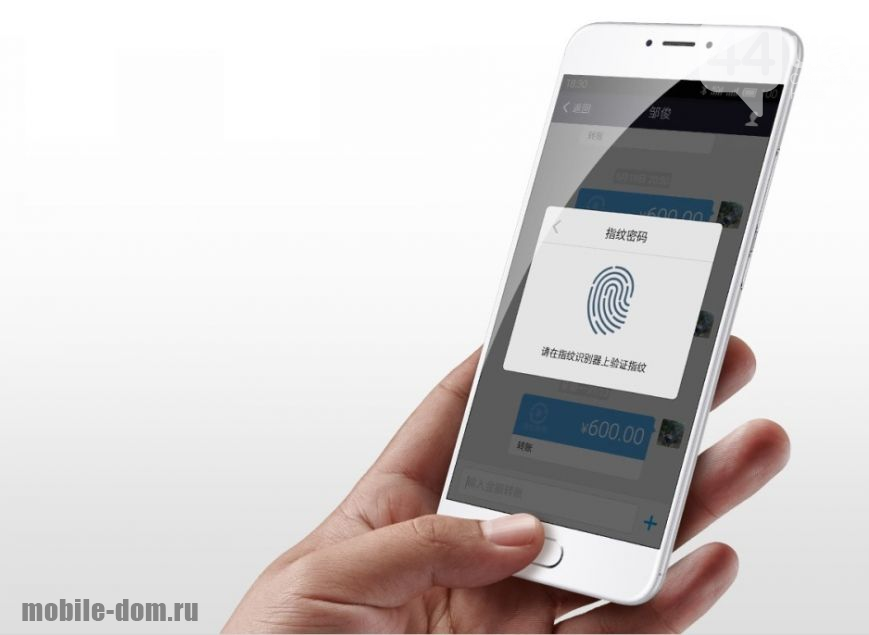
Fingerprint scanner
Conclusion
On this brief Meizu M3 Note review is over. Let us list the main pros and cons of this, which undoubtedly deserves close attention in budget segment, "Chinese".
Main advantages:
- high quality build and great appearance.
- large screen with excellent characteristics.
- Protected 2.5D glass with good oleophobic properties.
- powerful battery.
- one of best scanners fingerprints.
- fast and user-friendly interface Flyme.
- good quality cellular communications, Wi-Fi and GPS
Main disadvantages:
- lack of FM radio, infrared port and NFC support.
- Average quality camera and external sound.
- average graphics core performance.
To summarize, let's say that the Meizu M3 Note smartphone, unlike its predecessor M2 Note, has a metal body, an excellent fingerprint scanner, more powerful battery and a more sensitive camera, a good oleophobic screen coating, and the screen itself has become better. At the same time, it took on the appearance of the more expensive MX5 and Pro 5, and its performance is more than enough for “everyday” tasks.
